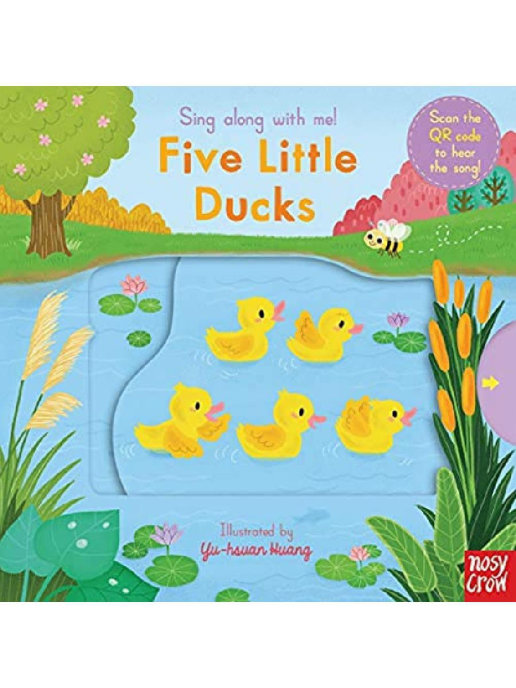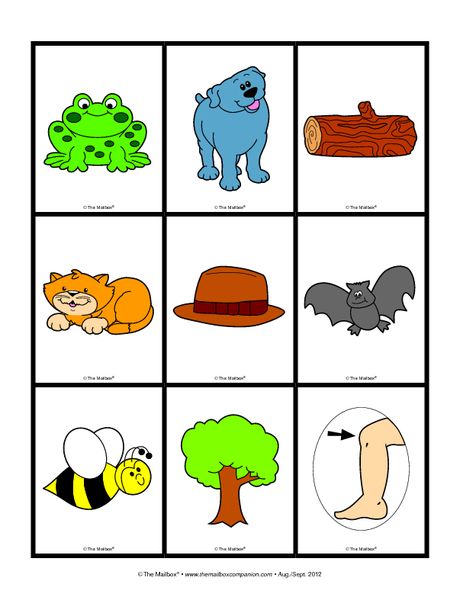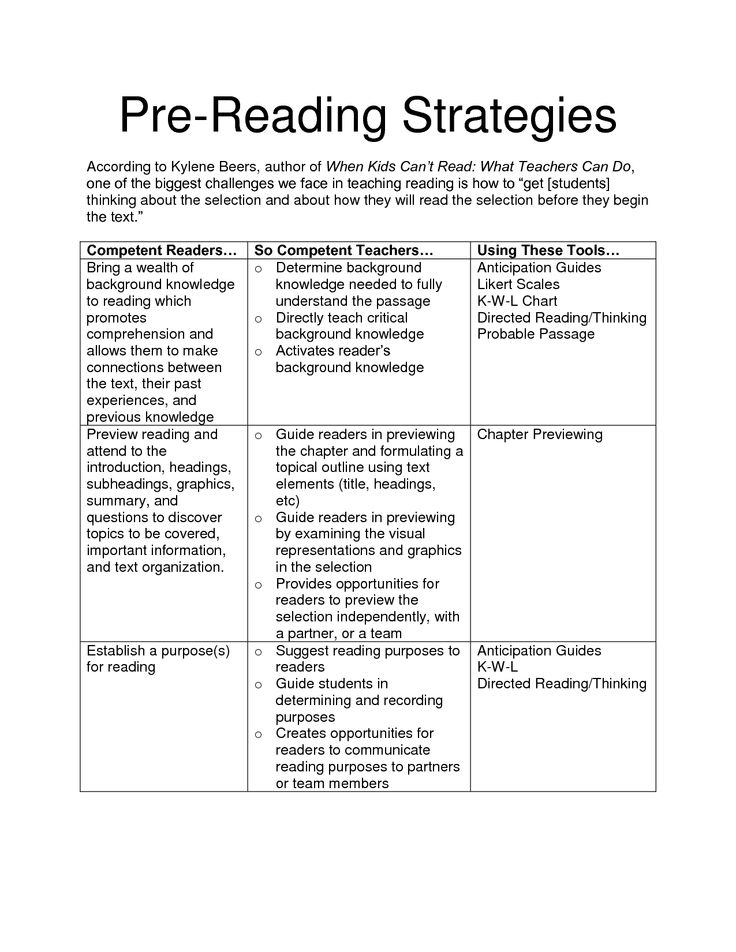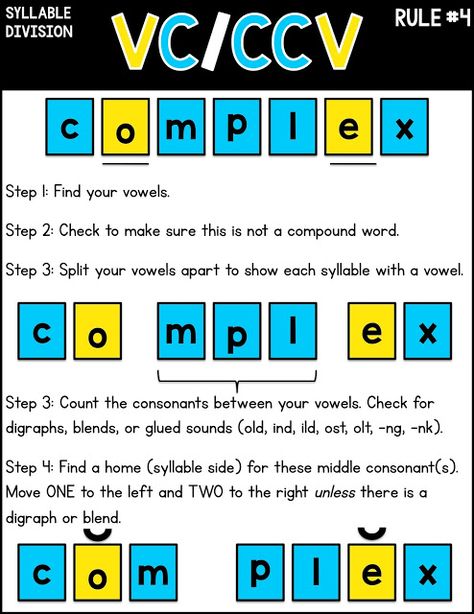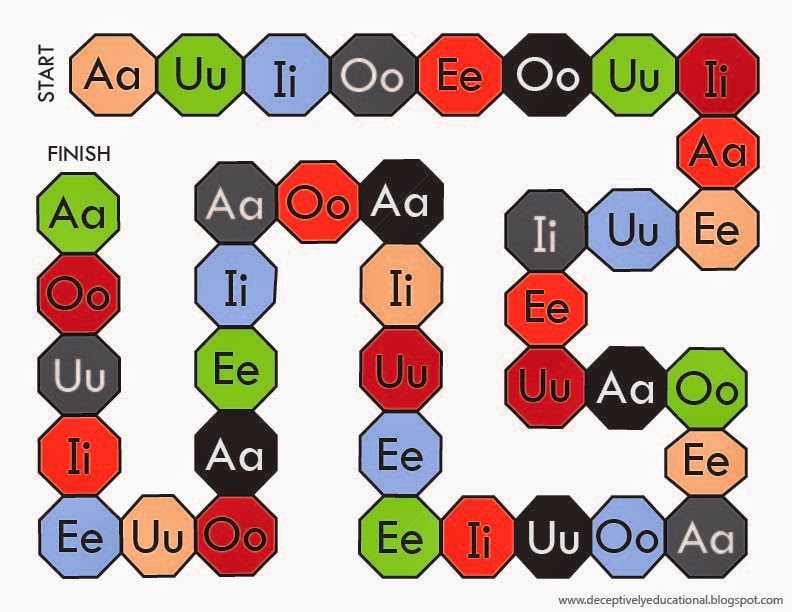All about the cats
Why Become a Foster?
All About the Cats is currently seeking loving foster homes and moms to hold kitties prior to adoption.
Why you should consider fostering:
If you’re looking for a way to help animals, consider fostering! It’s an experience like no other. There’s a foster out there for just about any situation or lifestyle. All you need is a little patience, a little space, and a lot of love.
Fostering Helps Increase Animal Adoptions
Every animal that moves into a foster home frees up space for a cat the rescue wouldn’t be able to take in otherwise. It’s that simple. More foster homes mean more animals saved. We as a rescue, remove an animal from a negative situation — be it a stray, victim of abuse, pet in need of medical care, or pulled from an overcrowded shelter – and rely entirely on foster guardians to home the animals until they’re adopted.
Some animals come into the rescue in great physical and mental shape and can go up for adoption right away. They may not need fostering. However, the support of foster families who take in other long-term cases means more resources are available to quickly transition the ready-to-adopt animals. This reduces stress on the animals and the rescue organization.
Fostering Keeps Adopted Cats in Their New Homes
Foster homes provide a much-needed opportunity to see how a rescue animal will react in a home environment, before going up for adoption. It’s a chance to discover and work through any behavioral issues, provide training and socialization, as well as allow them to decompress and readjust before adoption. This can be the difference between a successful adoption and a return to the rescue.
Fostering Helps Rehabilitation
For those willing to take rehabilitation cases, fostering is wonderful for animals going through medical recovery, resolving behavioral problems, or in need of socialization. Having a calm space, and someone dedicated to helping them heal, makes for a smoother and speedier recovery.
Fostering Helps Animals in Need
We tend to think of rescue animals as strays living on the streets, needing medical attention and finding a bit of relief with a rescue. While that’s true for many cases, it’s certainly not every case. Often times, owners may give up a pet if they feel they are not able to care for them properly. Sometimes elderly pet owners may find they’re unable to keep up with the physical demands. There are many reasons why beloved cats find themselves in rescues. You never know what life holds.
Fostering Provides Pre-Adoption Assessment and Adjustment
It’s a safe bet that an animal in the shelter environment isn’t showing their true personality. Shelter staff conduct behavior assessments and get to know them as best they can. But it’s not always a 100% reliable evaluation with all the stress and stimuli of a shelter environment.
Move that animal into a foster home, and it’s a totally different story. As a foster parent, you have the opportunity to see what kind of lifestyle the cat will thrive in, their likes and dislikes, whether they have any training or behavioral issues, fears, or special needs to be addressed. This insight is invaluable when we are trying to place the animal with the perfect forever family. We count on these insights to find the best possible adoption match for the animal.
This insight is invaluable when we are trying to place the animal with the perfect forever family. We count on these insights to find the best possible adoption match for the animal.
You’re also giving the cat a chance to settle back into themselves, shake off past negative experiences, let down their guard, and become a family member again before they step into their forever home. The last thing anyone wants is for an adoption to turn negative and a pet to be returned. But it happens. Allowing the animal to flow through a foster home first, sets everyone up for a more successful adoption and happy ever-after.
Fostering Animals is Good for Mental Health
Most foster cats generally stay in their room, separate from your own fur babies. You come to enjoy those moments, during a busy day, when you go into the foster room, close the door and can just sit in the quiet, focusing on nothing more than bonding with a cat who needs love.
What About Giving Up Your Foster Cat?
While we’re on the subject of health, it’s natural to wonder what happens when the time comes to say goodbye.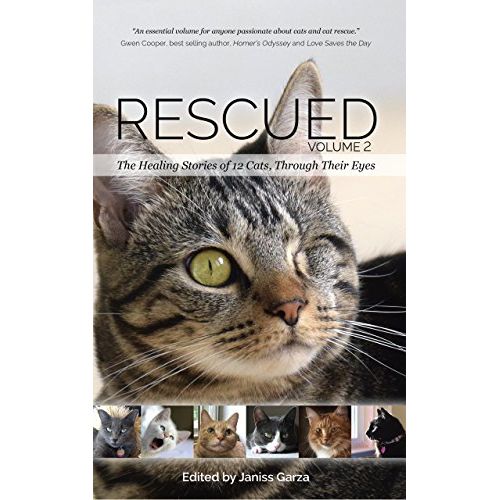 Here’s the way we look at it — our ultimate goal, at the end of the day, is to say goodbye to our fosters. That’s why we do what we do. It’s not a bad thing. It's success and means we did it — we got this little fur ball through. We showed them love and kept them safe. We helped them heal. All so they could have a beautiful life with a family who needs them.
Here’s the way we look at it — our ultimate goal, at the end of the day, is to say goodbye to our fosters. That’s why we do what we do. It’s not a bad thing. It's success and means we did it — we got this little fur ball through. We showed them love and kept them safe. We helped them heal. All so they could have a beautiful life with a family who needs them.
We’re only a step in their journey, not their destination. To sum up the emotions in one word … well … you can’t. One word isn’t enough. So here are the thoughts that come to mind: overwhelming happiness, sadness, a sigh of relief, a new opportunity for another foster cat in need, the start of the most amazing life for an animal.
Please consider fostering for AATC. If you have additional questions you can contact us at [email protected].
10 Best Cat Foods In 2022: Unbiased Review
Our Review Process
Our reviews are based on extensive research and, when possible, hands-on testing. Each time you make a purchase through one of our independently-chosen links, we’ll receive a percentage of the proceeds. Read more about how we’re supported here.
Each time you make a purchase through one of our independently-chosen links, we’ll receive a percentage of the proceeds. Read more about how we’re supported here.
Whether wet, dry, raw, or freshly-cooked, the best cat food honors your cat’s needs as an obligate carnivore.
It’s rich in animal-sourced protein, has the right amount of fatty acids, and doesn’t spike your cat’s blood sugar with excessive carbohydrates.
At a Glance: Best Cat Food To Buy In 2022
In the comparison table below, we’ve highlighted some of the most important features of each product. You’ll find more detailed information about each product later in the article
Overall Best
Runner Up
9.9
Picked by 3 people today!
Ziwi Peak Wet Cat Food
- Contains 92% fresh muscle meat, organs, and bone
- Rich in species-appropriate animal protein
- High-quality source of omega-3 fatty acids
Check Price
Best Wet Food
9.7
Picked by 2 people today!
Nulo Freestyle Turkey & Chicken Recipe Grain-Free Canned Cat Food
- Primarily animal-based recipe with low carb content
- Rich in moisture to support your cat’s hydration
- Plenty of omega-3 fatty acids for skin and coat health
Check Price
Best For Kittens
9. 5
5
Picked by 1 people today!
Wellness CORE Kitten Turkey & Chicken Liver Recipe Classic Pate Review
- Ultra-soft pâté texture is easy for kittens to eat
- Rich in protein and calories
- Hydrating canned food
Check Price
Best Dry
9.3
Picked by 4 people today!
Dr. Elsey’s cleanprotein Chicken Formula Grain-Free Dry Cat Food
- Rich in nourishing animal protein
- Extraordinarily low in carbohydrates
- Doesn’t contain any artificial colors, flavors, and preservatives
Check Price
Best Ethically-Sourced
9.3
Picked by 4 people today!
Open Farm Wild-Caught Salmon Dry Cat Food
- Food is made from responsibly-harvested fish
- Animal protein sources are the food’s primary ingredients
- Contains herring oil and salmon oil as rich sources of omega-3 fatty acids
Get 5% Off
Best Raw
8.8
Picked by 1 people today!
Stella & Chewy’s Freeze-Dried Raw Absolutely Rabbit Dinner Morsels Cat Food
- Rich in species-appropriate animal protein
- Contains guaranteed levels of probiotics to support the immune system and digestive health
- Added prebiotic fiber helps to prevent the constipation that some raw-fed cats experience
Check Price
Best For Urinary Health
9.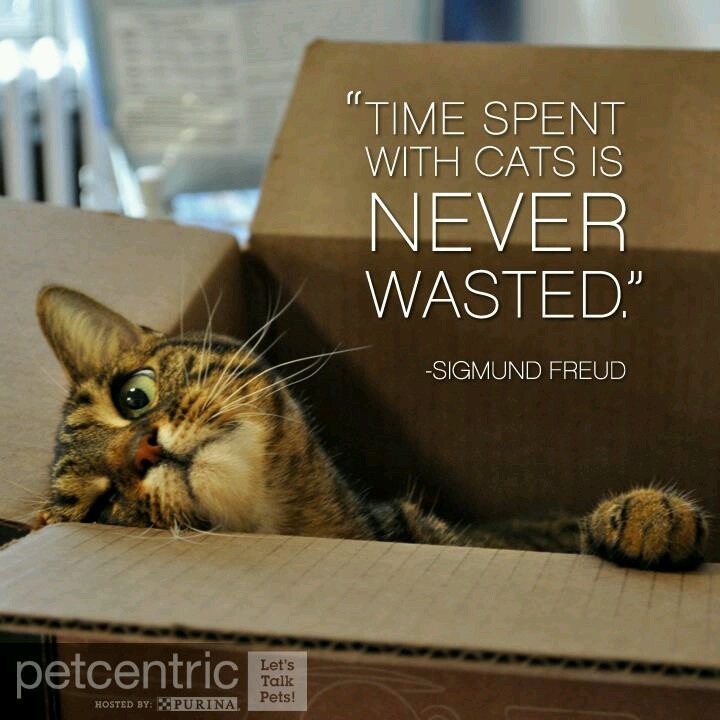 0
0
Picked by 1 people today!
Tiki Cat Puka Puka Luau Succulent Chicken
- Rich in nourishing animal protein
- High moisture content helps to flush the urinary tract
- Low ash shouldn’t contribute to crystal formation
Check Price
Best Dry Food for Picky Eaters
9.1
Picked by 1 people today!
Cat Person Chicken & Turkey Kibble
- Primarily made with animal-derived protein
- Free of vaguely-named ingredients
- Features animal-derived fat instead of plant oils
Check Price
Premium Pick
9.0
Picked by 1 people today!
Raised Right
- Recipes formulated by veterinarian, Dr. Karen Becker
- Limited ingredient whole food recipes that are low in carbs
- 100% human-grade food made in a USDA inspected facility
GET 20% OFF FIRST ORDER
Top Picks Explained
*Due to recurring availability and fulfillment issues, we’ve replaced Feline Natural with Smalls cat food as our top pick.
Why Should You Trust Us?
Having reviewed 181 of the world’s most popular cat food brands and hundreds of of formulas. We spent hours researching, contacting pet food companies, and analyzing labels. With the help of our cats, we also got hands-on experience with a few foods.
Finally, we consulted 7 veterinarians to get their professional opinion on what makes a great cat food.
Our Veterinary Advisors
- Dr. Sarah Wooten, DVM, CVJ
- Dr. Chris Vanderhoof, DVM, MPH
- Dr. Sarah Reidenbach, DVM
- Dr. Chyrle Bonk, DVM
- Dr. Jamie Whittenburg, DVM
- Dr. Albert Ahn, DVM
- Dr. Elizabeth Youens, DVM
In addition to performing our own qualitative analysis of the brands reviewed here, we submitted samples for analysis at an ISO 17025 certified food testing and analysis lab.
We bought the products at full retail price, and the entire testing process was funded by All About Cats without direct input or influence from the companies involved.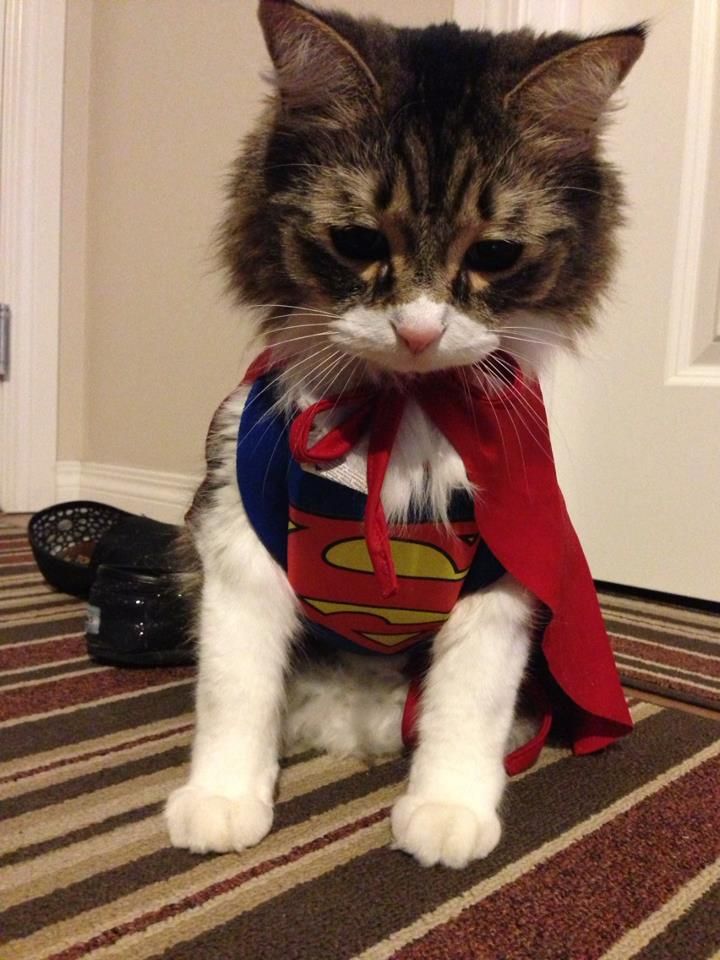
Analytical testing in a food chemistry lab gives us the exact macronutrient and micronutrient content of each recipe. The tests also look at microbial content, yeast, mold, and heavy metals, helping you ensure that you’re only putting the best in your cat’s bowl.
To access the lab reports for each food reviewed here, click the “view lab report” link in the product review.
Between reviewing specific brands, researching feline nutrition, and extensive laboratory testing we’ve learned which brands and products are worth buying and putting in your cat’s bowl.
Based on that experience, we’ve chosen the 10 products described below as the best cat food you can buy in 2022.
The Best Cat Food on the Market: Our Top Picks
At the top of the list is Smalls Cat Food. It’s hard to beat this wet food’s combination of outstanding protein content, emphasis on animal-sourced ingredients, and exclusion of additives that might harm your cat over time.
Though it satisfies our requirements for the best wet cat food, this product isn’t perfect for everyone. Our product roundup includes options for cats and people of all kinds.
You’ll find raw foods, products well-suited to cats with sensitive stomachs, and options that will help your cat lose weight.
#1 Overall Best: Smalls Fresh Cat Food
Overview:
- Brand Name: Smalls
- Made In: NYC, United States
- Guaranteed Protein: 15.5 % Min
- Age Range: All Life Stages
- Typical Cost Per Day: $2.00 to $3.50
ENTER “ALLABOUTCATS” TO GET 30% OFF YOUR FIRST ORDER
Read Our Full Brand Review View Lab Report
Smalls is a fresh cat food delivery service that uses human-grade ingredients, including premium proteins like chicken, turkey, and fish. Choose from minced-style recipes or classic pâté to provide your cat with protein-rich, low-carb cat food that’s formulated for cats in all life stages.
Though Smalls doesn’t portion out your cat’s meals for you, they do provide detailed feeding recommendations according to your cat’s calorie requirements. Each package of food contains about 16 ounces of food, with markings on the package at 50-calorie increments.
Smalls cat food is delivered frozen, so you’ll need to thaw the package overnight in the fridge first before feeding. Your subscription will be based on your cat’s calorie needs, and you can adjust it as needed by contacting the customer care team.
In addition to their fresh food, Smalls offers a selection of freeze-dried cat foods, treats, and meal toppers. They also recently started selling millet and silica cat litter.
Note: In June of 2021, Smalls issued a recall of several fresh food varieties following numerous reports of food that appeared to be spoiled. Smalls claims that there were no reports of illness associated with this recall, but the most recent customer comments and reviews suggest an uptick in cases of illness potentially associated with this food. We are waiting to get more concrete information on what happened, how it affected cats, and what Smalls is doing to resolve the problem.
We are waiting to get more concrete information on what happened, how it affected cats, and what Smalls is doing to resolve the problem.
This is the latest in a string of issues affecting Smalls customers, including inconsistent deliveries and limited access to customer care.
Learn more about this recall in the company’s announcement and in our Smalls brand review.
Top Recipe: Smalls Fresh Ground Bird
Featuring chicken and chicken liver as the top two ingredients, this fresh food is packed with premium animal protein. Green beans, peas, and kale are the only carbohydrate ingredients and they are naturally grain-free and rich in nutrients.
In addition to being high in protein and low in carbohydrates, this formula is rich in moisture, which helps with hydration and promotes lean body mass. Overall, this minced chicken recipe is a high-quality source of balanced nutrition for cats in all life stages.
Ingredients:
Chicken, Chicken liver, Green beans, Peas, Water (sufficient for processing), Chicken hearts, Kale, Tricalcium phosphate, Canola oil, Choline chloride, Potassium chloride, Salt, Taurine, Magnesium Sulfate, Niacinamide, Ferrous sulfate, Zinc sulfate, Vitamin E supplement, Thiamine mononitrate (vitamin B1), Calcium pantothenate (vitamin B5), Copper sulfate, Pyridoxine hydrochloride (vitamin B6), Manganese sulfate, Riboflavin (vitamin B2), Potassium iodide, Folic acid, Biotin (vitamin B7), Vitamin B12 supplement, Vitamin D3 supplement
Guaranteed Analysis
Crude Protein: 15.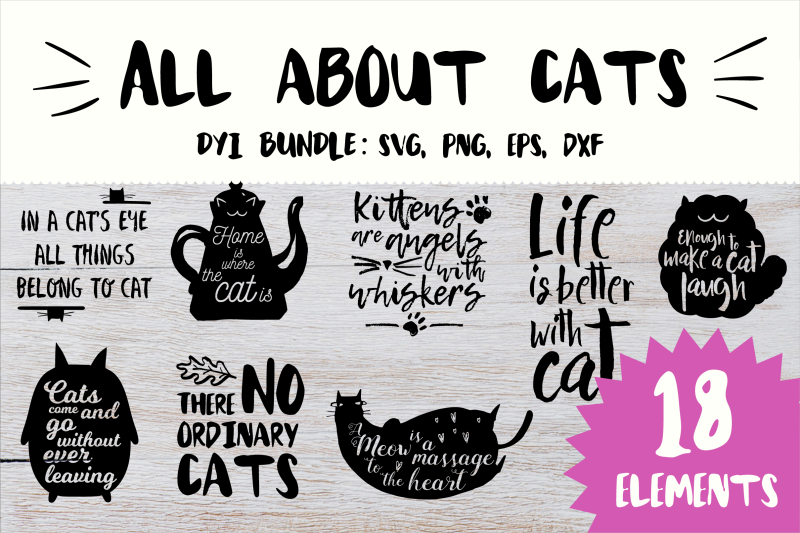 5%
5%
Crude Fat: 8.5%
Crude Fiber: 1.5%
Moisture: 72%
Dry Matter Basis
Protein: 55.36%
Fat: 30.36%
Fiber: 5.36%
Carbs: 8.93%
Caloric Weight Basis
Protein: 40.11%
Fat: 53.42%
Carbs: 6.47%
What We Liked:
- Fresh food made with human-grade ingredients
- High-quality animal protein
- High in protein very low in carbs
- Moisture-rich
What We Didn’t Like:
- Not individually portioned for your cat
- Limited protein options (chicken, turkey, beef)
#2 Runner Up: Ziwi Peak Venison Recipe Canned Cat Food
Overview:
- Brand Name: Ziwi Peak
- Made In: New Zealand
- Guaranteed Protein: 10% min
- Age Range: All Life Stages
- Typical Cost Per Day: $8.
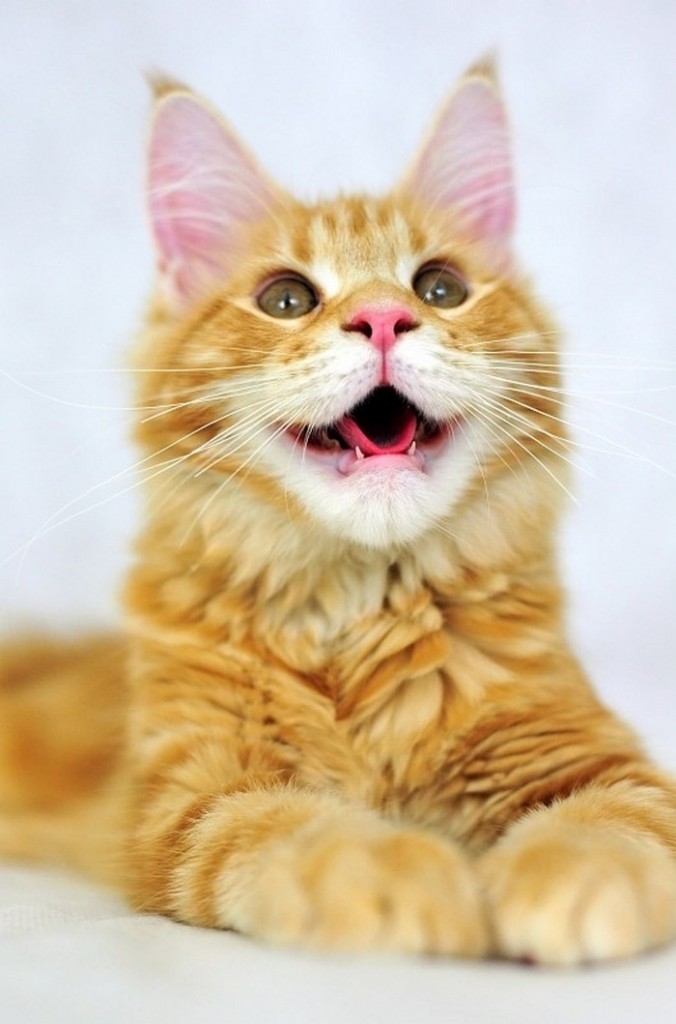 28/day
28/day
Buy On ChewyBuy On Amazon
Read Our Full Brand Review View Lab Report
Ziwi Peak is a New Zealand-based pet food company that uses ethical and sustainable ingredients, including meat and seafood sourced 100% from New Zealand. Their proteins are farmed without hormones, antibiotics, or growth promotants, and their seafood comes from the world’s top-ranked fisheries. Choose from a wide variety of air-dried and wet cat food recipes.
Every Ziwi Peak recipe features high percentages of meat, organs, and seafood, which is in keeping with their PeakPrey ratios. Real meat, poultry, or seafood are the foundations of every formula, and every recipe is free from fillers, artificial preservatives, and high glycemic ingredients.
Top Recipe: Ziwi Peak New Zealand Venison Recipe Cat Food
This protein-packed formula features 100% single-sourced New Zealand venison. Made with 92% fresh meat, organs, and bone, this recipe is rich in species-appropriate animal protein, omega-3 fatty acids, and natural sources of joint-supporting glucosamine and chondroitin.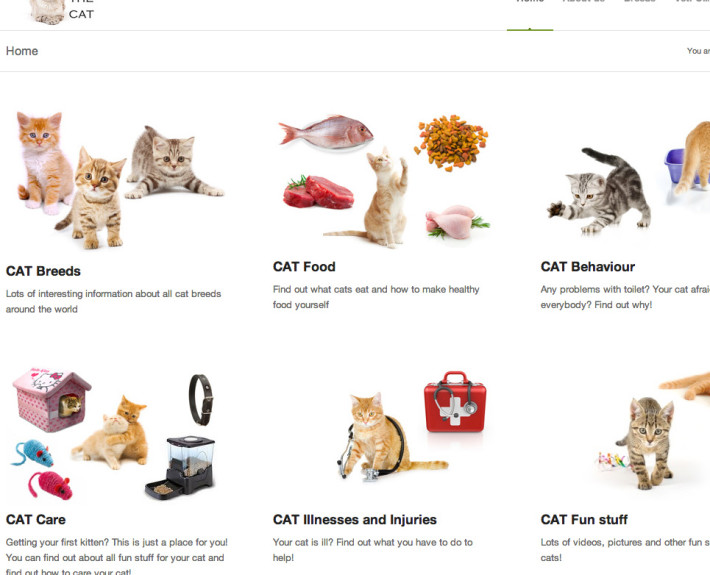 It is completely free from low-quality grains, fillers, and artificial additives.
It is completely free from low-quality grains, fillers, and artificial additives.
Overall, this recipe provides an excellent source of balanced nutrition for cats in all life stages. It comes in a chunky loaf style recipe with high levels of moisture and enticing pieces of venison.
Ingredients:
Venison, Water Sufficient for Processing, Venison Tripe, Venison Liver, Chickpeas, Venison Lung, Venison Heart, Venison Kidney, New Zealand Green Mussel, Venison Bone, DL-Methionine, Dried Kelp, Minerals (Magnesium Sulfate, Zinc Amino Acid Complex, Manganese Amino Acid Complex, Copper Amino Acid Complex), Taurine, Vitamins (Vitamin E Supplement, Thiamine Mononitrate, Pyridoxine Hydrochloride, Vitamin D3 Supplement, Folic Acid).
Guaranteed Analysis
Crude Protein: 10%
Crude Fat: 4%
Crude Fiber: 2%
Moisture: 78%
Ash: 3%
Dry Matter Basis
Protein: 45.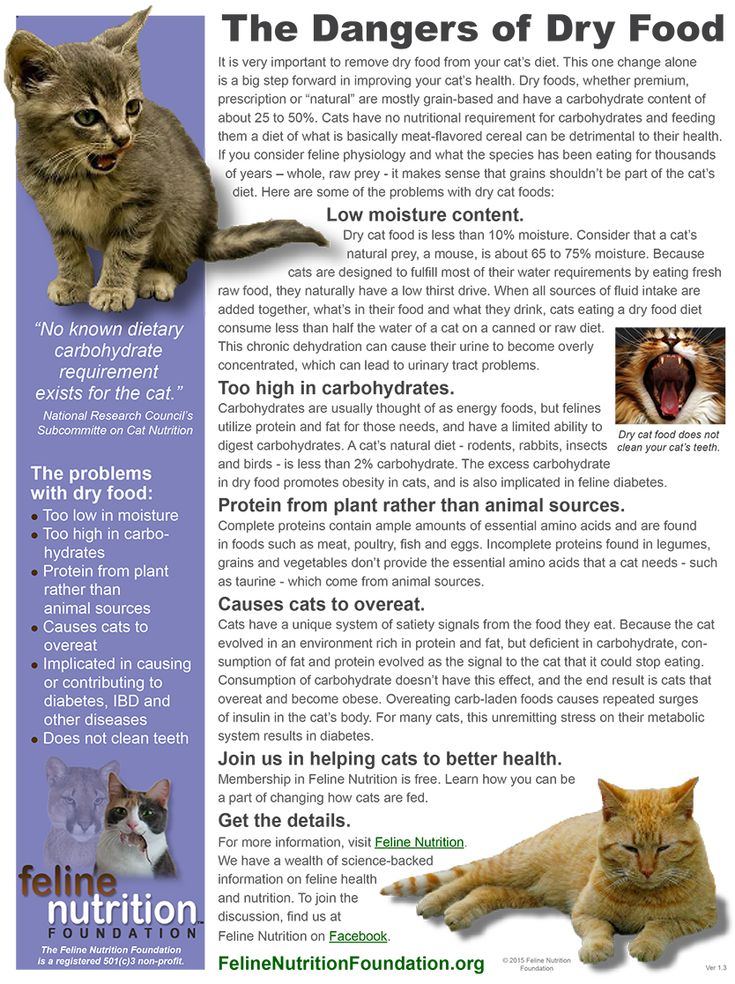 45%
45%
Fat: 18.18%
Fiber: 9.09%
Carbs: 13.64%
Caloric Weight Basis
Protein: 44.03%
Fat: 42.77%
Carbs: 13.21%
What We Liked:
- Contains 92% fresh muscle meat, organs, and bone
- Rich in species-appropriate animal protein
- A high-quality source of omega-3 fatty acids
- Doesn’t contain any potentially harmful ingredients
What We Didn’t Like:
- Carbohydrates (chickpeas) aren’t necessary for cats
- Some cats don’t like the way the food tastes
- One of the most expensive cat foods you can buy
#3 Best Wet Food: Nulo Freestyle Turkey & Chicken Recipe Grain-Free Canned Cat Food
Overview:
- Brand Name: Nulo
- Made In: United States
- Guaranteed Protein: 11% Min
- Age Range: All Life Stages
- Typical Cost Per Day: $2.
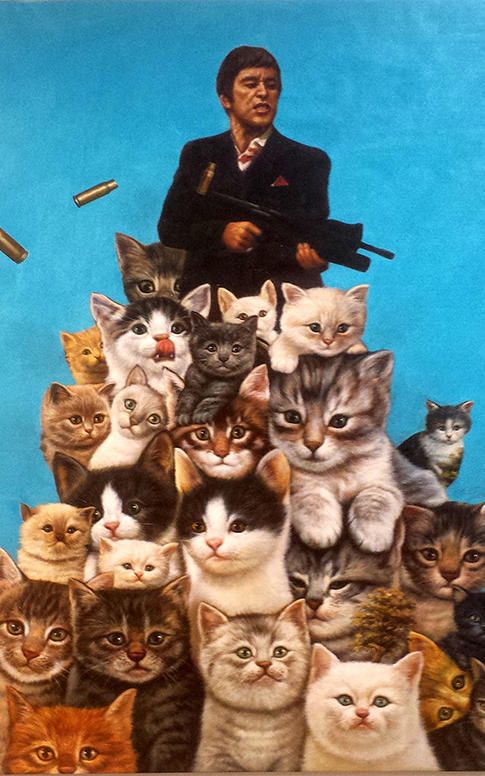 29
29
Buy On Chewy Buy On Amazon
Read Our Full Brand Review View Lab Report
Wet food contains a significant amount of hydrating moisture for cats, especially in comparison to the average dry food. In addition to supporting your cat’s hydration, wet food may also be easier for some cats to digest.
This Nulo Freestyle formula is a meat-based recipe featuring fresh turkey, chicken, and chicken liver with supplemental protein from fresh tuna. Menhaden fish oil is a species-appropriate source of omega-3 fatty acids to help support your cat’s skin and coat.
While this recipe does contain a few added plant ingredients, the overall carbohydrate content is still fairly low – especially in comparison to the average dry food. It doesn’t contain grains or difficult-to-digest beans and legumes, but it does contain added fiber from cranberries and pumpkin.
The fiber content of this recipe is within the appropriate range for cats but it’s worth noting that certain starchy thickeners like guar gum have been linked to soft stools in some cats.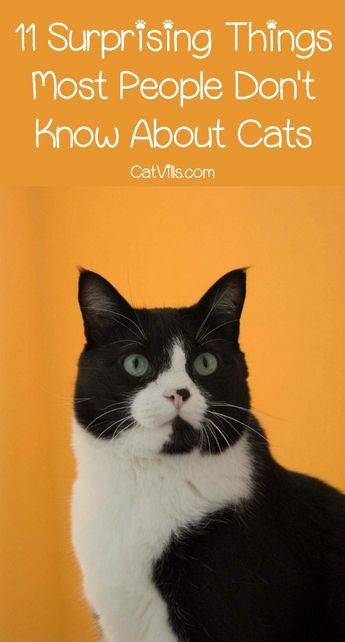 For the most part, based on customer reviews, however, cats seem to enjoy this recipe and tend to tolerate it well.
For the most part, based on customer reviews, however, cats seem to enjoy this recipe and tend to tolerate it well.
Ingredients
Turkey, Chicken, Turkey Liver, Turkey Broth, Tuna, Natural Flavor, Guar Gum, Potassium Chloride, Agar Agar, Choline Chloride, Taurine, Cranberries, Pumpkin, Menhaden Fish Oil (Preserved With Mixed Tocopherols), Tomato, Dried Kelp, Yucca Schidigera Extract, Salt, Iron Proteinate, Sodium Carbonate, Zinc Proteinate, Thiamine Mononitrate, Vitamin E Supplement, Magnesium Sulfate, Copper Proteinate, Manganese Proteinate, Sodium Selenite, Niacin Supplement, d-Calcium Pantothenate, Pyridoxine Hydrochloride, Riboflavin Supplement, Vitamin A Supplement, Biotin, Potassium Iodide, Vitamin D3 Supplement, Vitamin B12 Supplement, Folic Acid, Rosemary Extract.
Guaranteed Analysis
Crude Protein: 11%
Crude Fat: 6.5%
Crude Fiber: 0.75%
Moisture: 78%
Dry Matter Basis
Protein: 50%
Fat: 29. 55%
55%
Fiber: 3.41%
Carbs: 17.05%
Caloric Weight Basis
Protein: 36.02%
Fat: 51.7%
Carbs: 12.28%
What We Liked:
- Primarily animal-based recipe with low carb content
- Rich in moisture to support your cat’s hydration
- Plenty of omega-3 fatty acids for skin and coat health
- Doesn’t contain grains, fillers, or artificial additives
What We Didn’t Like:
- Somewhat expensive
- Guar gum may cause soft stools in some cats
#4 Best For Kittens: Wellness CORE Kitten Turkey & Chicken Liver Recipe Classic Pate Review
Overview:
- Brand Name: Wellness CORE
- Made In: United States
- Guaranteed Protein: 12% Min
- Age Range: Kitten
- Typical Cost Per Day: $1.14/day
Buy On ChewyBuy On Amazon
Read Our Full Brand Review
This Wellness CORE food has everything we look for in kitten food.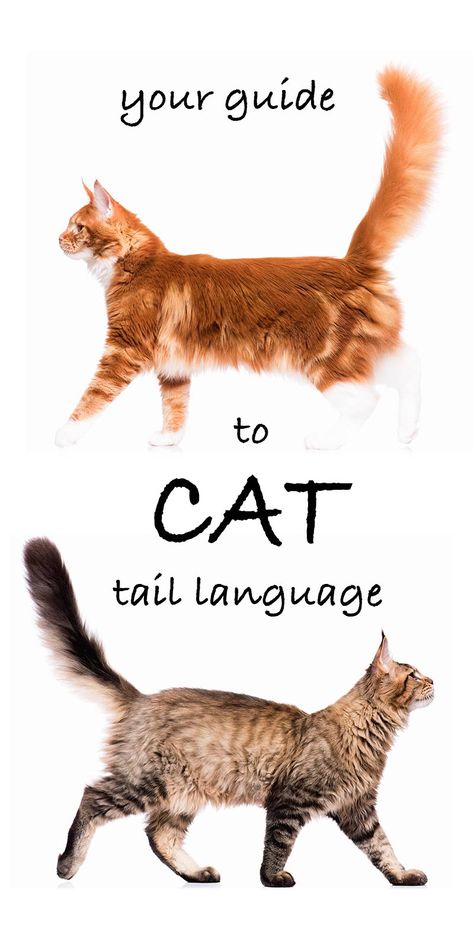 It’s loaded with nourishing animal protein from turkey, chicken liver, chicken muscle meat, and chicken meal.
It’s loaded with nourishing animal protein from turkey, chicken liver, chicken muscle meat, and chicken meal.
Also Read: Best Wet Food For Kittens
Herring and menhaden fish oil make the food a good source of DHA, an omega-3 fatty acid that contributes to brain and eye development. With 108 calories per can, it’s calorie-dense enough to fuel your kitten’s growth and development.
Ingredients:
Turkey, Chicken Liver, Turkey Broth, Chicken, Chicken Meal, Herring, Natural Flavor, Cranberries, Menhaden Fish Oil (preserved with Mixed Tocopherols), Guar Gum, Tricalcium Phosphate, Ground Flaxseed, Potassium Chloride, Choline Chloride, Taurine, Cassia Gum, Xanthan Gum, Dried Kelp, Chicory Root Extract, Yucca Schidigera Extract, Alfalfa Meal, Salt, Magnesium Sulfate, Iron Proteinate, Zinc Proteinate, Thiamine Mononitrate, Vitamin E Supplement, Copper Proteinate, Manganese Proteinate, Sodium Selenite, Niacin, d-Calcium Pantothenate, Pyridoxine Hydrochloride, Riboflavin Supplement, Vitamin A Supplement, Biotin, Potassium Iodide, Vitamin D3 Supplement, Vitamin B12 Supplement, Folic Acid, Rosemary Extract.
Guaranteed Analysis
Crude Protein: 12%
Crude Fat: 7.5%
Crude Fiber: 1%
Moisture: 78%
Dry Matter Basis
Protein: 54.55%
Fat: 34.09%
Fiber: 4.55%
Carbs: 6.82%
Caloric Weight Basis
Protein: 37.84%
Fat: 57.43%
Carbs: 4.73%
What We Liked:
- Ultra-soft pâté texture is easy for kittens to eat
- Rich in protein and calories
- Hydrating canned food
- Supplemented with fish oil as a species-appropriate source of DHA
What We Didn’t Like:
- Contains some unnecessary plant ingredients
#5 Best Dry: Dr. Elsey’s cleanprotein Chicken Formula Grain-Free Dry Cat Food
Overview:
- Brand Name: Dr. Elsey’s
- Made In: United States
- Food Form: Dry Food
- Guaranteed Protein: 59% Min
- Life Stage: Adult
- Typical Cost Per Day: $0.
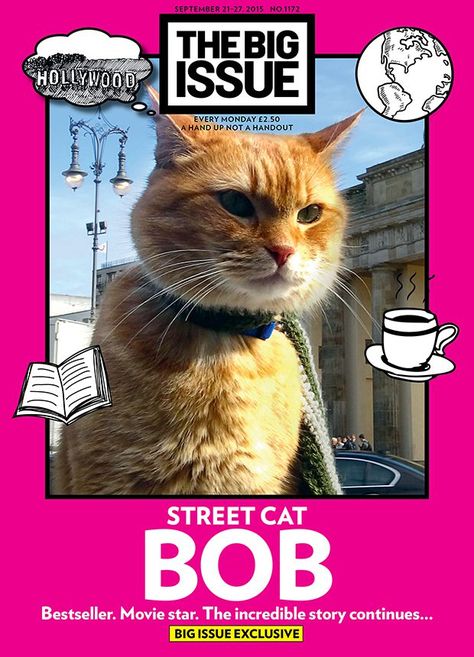 80/day
80/day
Buy On ChewyBuy On Amazon
Read Our Full Brand Review View Lab Report
This food is a refreshing switch from the high-carbohydrate content and gobs of plant protein found in typical dry foods. Instead, it’s made primarily from chicken, egg, pork protein isolate, and other sources of species-appropriate nutrition. While other foods rely on high-carbohydrate binders like corn, wheat, soy, and potatoes, this food uses gelatin as its primary binding agent.
Overall, the food provides carnivore-appropriate nutrition with plenty of protein, species-appropriate fat, and not a lot of carbohydrates.
The food’s meaty makeup makes it more calorie-dense and efficient than most dry foods. You’ll feed your cat less and see reduced waste in the litter box.
On Chewy, 93% of customers say they’d recommend the food to a friend. It receives primarily positive customer reviews, with most customers saying their cats love the way it tastes. The biggest complaint about this food is its price—it’s considerably more expensive than your typical dry cat food.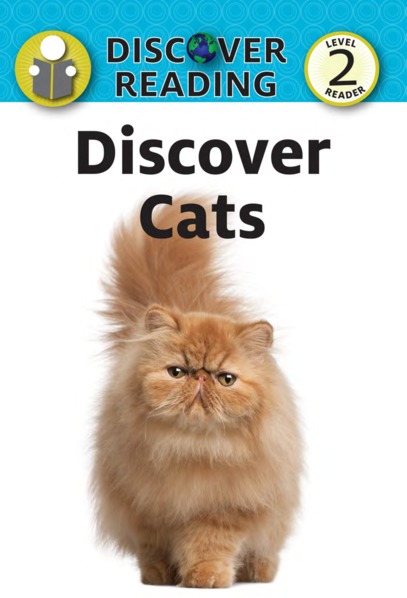
Ingredients:
Chicken, Dried Egg Product, Pork Protein Isolate, Gelatin, Chicken Fat (Preserved With Mixed Tocopherols), Flaxseed, Natural Flavor, Salmon Oil, Potassium Citrate, Calcium Carbonate, Fructooligosaccharide, Calcium Carbonate, Choline Chloride, Vitamins (Vitamin E Supplement, Niacin Supplement, D-Calcium Pantothenate, Vitamin A Acetate, Thiamine Mononitrate, Pyridoxine Hydrochloride, Riboflavin Supplement, Vitamin D3 Supplement, Biotin, Vitamin B12 Supplement, Folic Acid), Minerals (Ferrous Sulfate, Zinc Oxide, Calcium Carbonate, Manganous Oxide, Copper Sulfate, Iron Amino Acid Chelate, Manganese Amino Acid Chelate, Zinc Amino Acid Chelate, Copper Amino Acid Chelate, Sodium Selenite, Cobalt Carbonate, Ethylenediamine Dihydroiodide), Potassium Chloride, Mixed Tocopherols (Preservative), Taurine, Salt, Rosemary Extract.
Guaranteed Analysis
Crude Protein: 59%
Crude Fat: 18%
Crude Fiber: 4%
Moisture: 12%
Dry Matter Basis
Protein: 67. 05%
05%
Fat: 20.45%
Fiber: 4.55%
Carbs: 7.95%
Caloric Weight Basis
Protein: 53.78%
Fat: 39.84%
Carbs: 6.38%
What We Liked:
- Rich in nourishing animal protein
- Features chicken fat and salmon oil as sources of the fatty acids that cats need
- Extraordinarily low in carbohydrates, compared to other dry foods
- Doesn’t contain any artificial colors, flavors, and preservatives
What We Didn’t Like:
- Like all dry foods, this product fails to provide the moisture that cats need
- Expensive compared to other dry foods
#6 Best Ethically-Sourced: Open Farm Wild-Caught Salmon Dry Cat Food
Overview:
- Brand Name: Open Farm
- Made In: United States
- Guaranteed Protein: 37% min
- Age Range: All Life Stages
- Typical Cost Per Day: $0.
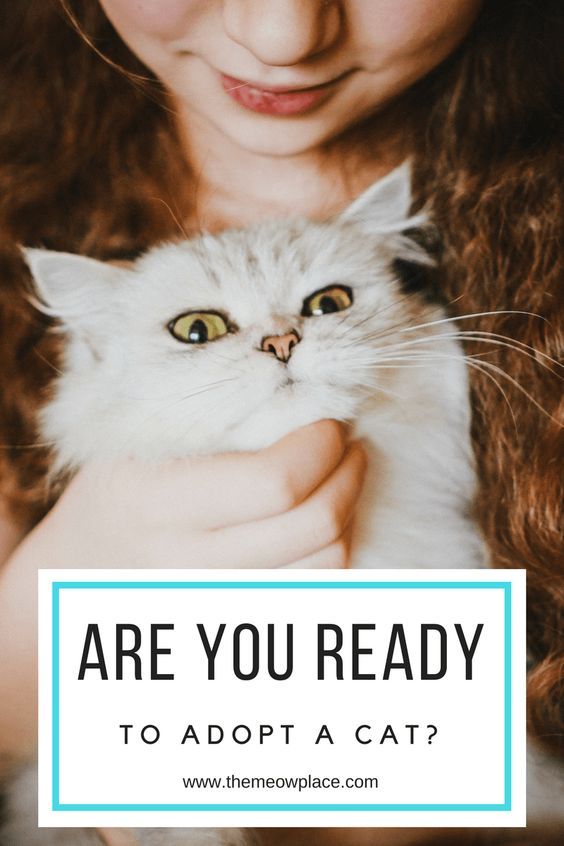 68/day
68/day
Click Here To Get 5% Off Buy On Amazon
Read Our Full Brand Review View Lab Report
While our number one dry food recommendation scores well in terms of nutritional value and our feline reviewers enjoyed it, no food will appeal to every cat.
If you have a picky kibble consumer, Open Farm’s Wild-Caught Salmon dry cat food might be a good choice for you. This food receives excellent customer reviews, with most reporting that their cats loved its taste.
And unlike many other kibble products that rate well in feline taste tests, this food from Open Farm is made from responsibly-sourced, seemingly high-quality ingredients. Open Farm’s sourcing policy emphasizes humanely-raised poultry, meat, and fish. Fish-based recipes, like the one featured here, are made from sustainably-harvested wild-caught fish.
With salmon, ocean whitefish meal, and herring meal as the first three ingredients, this food appears to make species-appropriate protein sources the backbone of its recipe.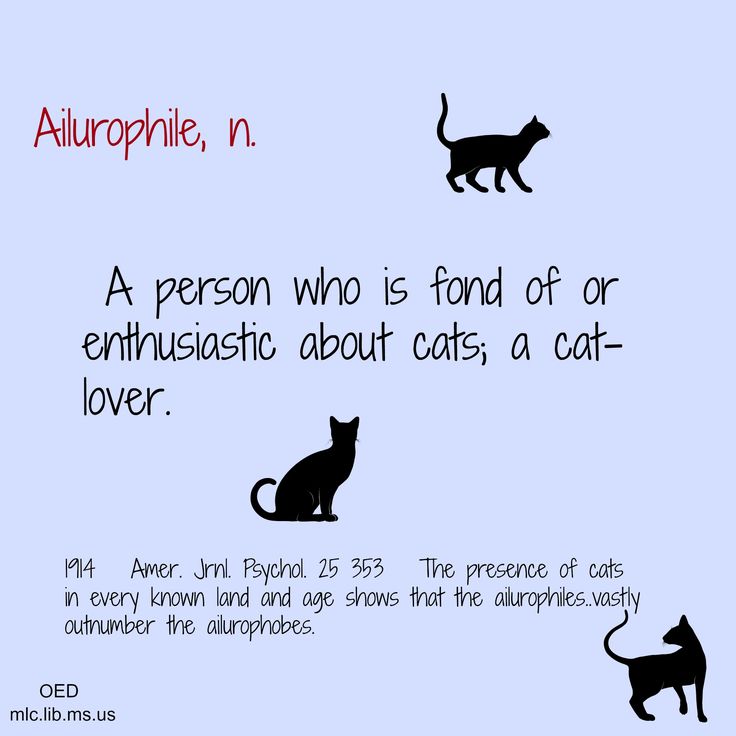
Like other grain-free dry foods, it also contains legumes and other plant ingredients, but it’s a carnivore-friendly choice compared to the competition.
Overall, if you’re looking for a food that excites your cat and also like the idea of supporting initiatives to make cat food more environmentally-friendly, this recipe from Open Farm could be a good choice.
Ingredients:
Wild Pacific Salmon, Ocean Whitefish Meal, Ocean Herring Meal, Garbanzo Beans (Chickpeas), Red Lentils, Coconut Oil (preserved with mixed tocopherols), Herring Oil (preserved with mixed tocopherols), Pumpkin, Natural Flavour, Green Lentils, Salmon Oil, Non-GMO Cranberries, Chicory Root, Apples, Dandelion Greens, Choline Chloride, Salt, Turmeric, Dried Yucca Schidigera Extract, Potassium Chloride, Mixed Tocopherols (a natural preservative), Calcium Carbonate, Zinc Proteinate, Iron Proteinate, Copper Proteinate, Manganese Proteinate, Sodium Selenite, Calcium Iodate, Vitamin E Supplement, Thiamine Mononitrate, Niacin Supplement, D-calcium Pantothenate, Biotin, Vitamin A Acetate, Riboflavin Supplement, Vitamin B12 Supplement, Vitamin, D3 Supplement, Folic Acid, Taurine, Rosemary Extract
Guaranteed Analysis
Crude Protein: 37%
Crude Fat: 18%
Crude Fiber: 3%
Moisture: 10%
Dry Matter Basis
Protein: 41.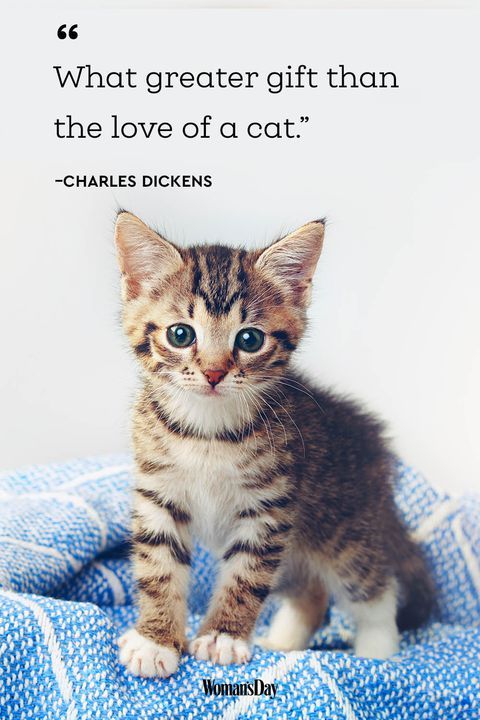 11%
11%
Fat: 20%
Fiber: 3.33%
Carbs: 35.56%
Caloric Weight Basis
Protein: 32.83%
Fat: 38.78%
Carbs: 28.39%
What We Liked:
- According to Open Farm, this food is made from responsibly-harvested fish
- Animal protein sources are the food’s primary ingredients
- Contains herring oil and salmon oil as rich sources of omega-3 fatty acids
- Free of potentially-harmful artificial colors, flavors, and preservatives
- Cats tend to love the taste of this food
What We Didn’t Like:
- Relatively high in carbohydrates
Expensive compared to some other dry cat foods
#7 Best Raw: Stella & Chewy’s Freeze-Dried Raw Absolutely Rabbit Dinner Morsels Cat Food
Overview:
- Brand Name: Stella & Chewy’s
- Made In: United States
- Food Form: Freeze-Dried
- Guaranteed Protein: 45% Min
- Life Stage: Adult
- Typical Cost Per Day: $0.
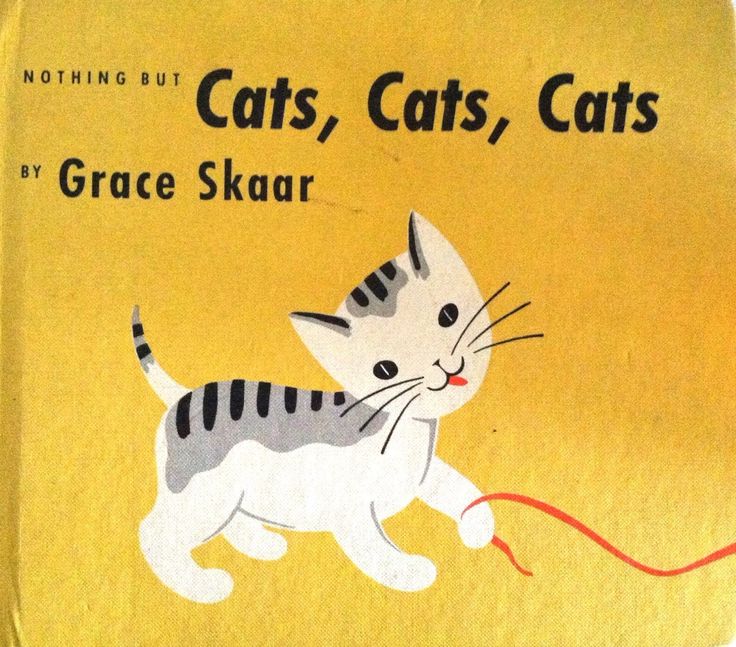 80/day
80/day
Buy On ChewyBuy On Amazon
Read Our Full Brand Review View Lab Report
Stella and Chewy’s is one of the leading companies in raw cat food—their foods are affordable, varied, and taste great. While their foods are also available in frozen varieties, we like the convenience of freeze-dried food.
This freeze-dried recipe is primarily made from rabbit meat, organs, and bones. Rabbit is a feline favorite and often a good option for cats suffering from food sensitivities and allergies. Along with rabbit, this recipe contains prebiotics and probiotics to keep your cat’s digestive system healthy and their immune system strong.
Also Read: 10 Best Probiotics for Cats
With its meat-first ingredient list and minimal carbohydrate content, this is a species-appropriate choice that embodies the value of raw cat food.
Ingredients:
Rabbit With Ground Bone, Rabbit Liver, Olive Oil, Pumpkin Seed, Potassium Chloride, Sodium Phosphate, Choline Chloride, Dried Ediococcus Acidilactici Fermentation Product, Dried Lactobacillus Acidophilus Fermentation Product, Dried Bifidobacterium Longum Fermentation Product, Dried Bacillus Coagulans Fermentation Product, Taurine, Tocopherols (Preservative), Dandelion, Dried Kelp, Zinc Proteinate, Iron Proteinate, Vitamin A Supplement, Vitamin E Supplement, Niacin Supplement, Copper Proteinate, Riboflavin Supplement, Sodium Selenite, D-Calcium Pantothenate, Biotin, Manganese Proteinate, Thiamine Mononitrate, Pyridoxine Hydrochloride, Vitamin D3 Supplement, Folic Acid, Vitamin B12 Supplement.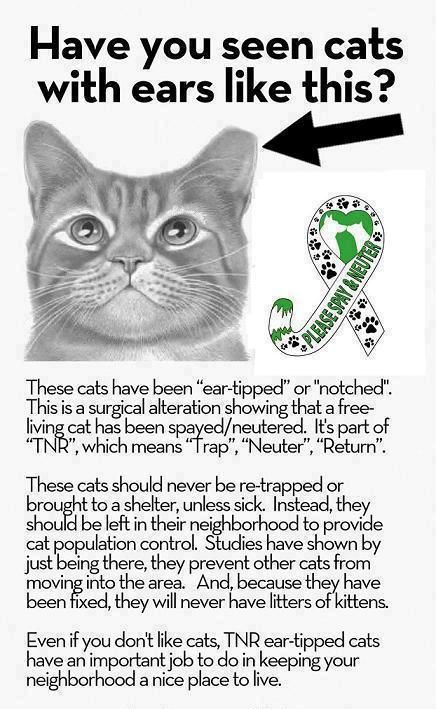
Guaranteed Analysis
Crude Protein: 44%
Crude Fat: 30%
Crude Fiber: 5%
Moisture: 5%
Dry Matter Basis
Protein: 46.32%
Fat: 31.58%
Fiber: 5.26%
Carbs: 16.84%
Caloric Weight Basis
Protein: 33.12%
Fat: 54.84%
Carbs: 12.04%
What We Liked:
- Rich in species-appropriate animal protein
- Contains guaranteed levels of probiotics to support the immune system and digestive health
- Added prebiotic fiber helps to prevent the constipation that some raw-fed cats experience
- Low carbohydrate content
- Doesn’t contain any potentially harmful additives
What We Didn’t Like:
- Freeze-dried food takes a few minutes to rehydrate
- Some cats don’t like the rabbit taste
#8 Best For Urinary Health: Tiki Cat Puka Puka Luau Succulent Chicken
Overview:
- Brand Name: Tiki Cat
- Made In: Thailand
- Guaranteed Protein: 16% Min
- Age Range: Adult
- Typical Cost Per Day: $4.
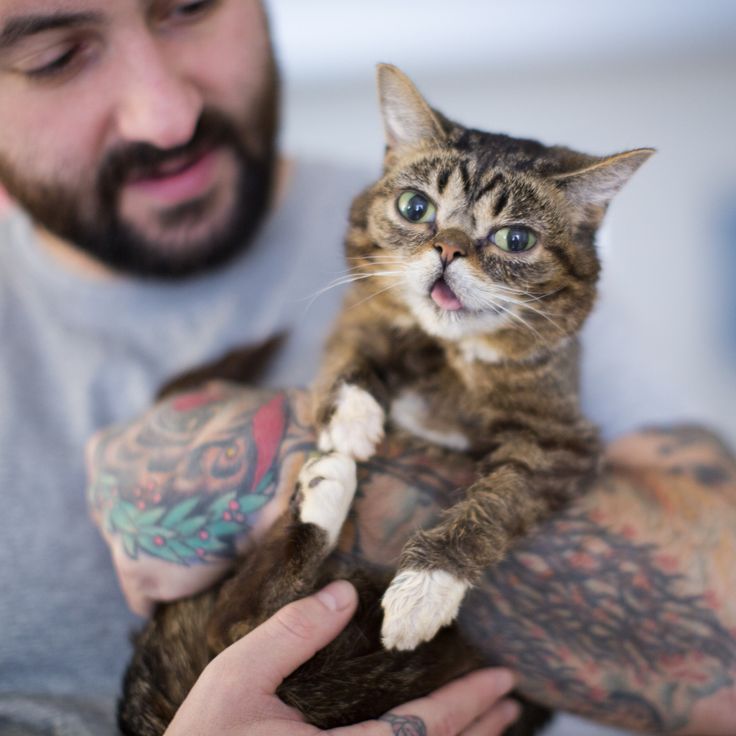 32/day
32/day
Buy On ChewyBuy On Amazon
Read Our Full Brand Review View Lab Report
Veterinarians, nutritionists, and other experts agree that high-moisture diets are the best choice for feline lower urinary tract disease prevention.
Depending on the cause of your cat’s urinary tract disease, cats may thrive on a diet made to control struvite or calcium oxalate crystals.
In short, choose a food that’s not dry, even if it’s a prescription formula for urinary tract health. Once you’ve gotten that basic requirement, you can start thinking about other factors, like the food’s pH and ash content.
Also Read: 7 Best Cat Foods For Urinary Tract Health
This recipe from Tiki Cat is low in ash, which will help lower the risk of urinary crystal formation. This recipe also has enough moisture to flush the urinary tract and has a species-appropriate pH that won’t cause crystal formation.
Ingredients:
Chicken, Chicken Broth, Sunflower Seed Oil, Tricalcium Phosphate, Taurine, Choline Chloride, Potassium Chloride, Sodium Chloride, Magnesium Sulfate, Zinc Amino Acid Chelate, Iron Amino Acid Chelate, Vitamin E Supplement, Ascorbic Acid, Thiamine Mononitrate (Vitamin B1), Niacin (Vitamin B3), Manganese Amino Acid Chelate, Vitamin A Supplement, Copper Amino Acid Chelate, Calcium Iodate, Calcium Pantothenate, Sodium Selenite, Riboflavin Supplement (Vitamin B2), Vitamin B12 Supplement, Pyridoxine Hydrochloride (Vitamin B6), Folic Acid, Vitamin D3 Supplement, Biotin, Vitamin K3 Supplement.
Guaranteed Analysis
Crude Protein: 16%
Crude Fat: 2.6%
Moisture: 80%
Ash: 1.6%
Dry Matter Basis
Protein: 80%
Fat: 13%
Caloric Weight Basis
Protein: 71.7%
Fat: 28.3%
What We Liked:
- Rich in nourishing animal protein
- High moisture content helps to flush the urinary tract
- Low ash shouldn’t contribute to crystal formation
- Species-appropriate pH helps keep things in balance
What We Didn’t Like:
- Contains sunflower oil instead of species-appropriate animal fat
- Low fat content isn’t right for every cat
#9 Best Dry Food for Picky Eaters: Cat Person Chicken & Turkey Kibble
Overview:
- Brand Name: Cat Person
- Made In: United States
- Guaranteed Protein: 40% min
- Life Stage: Adult
- Typical Cost Per Day: $0.
 68/day
68/day
Buy On CatPerson.com
Read Our Full Brand Review
If your cat’s not interested in other products, Cat Person’s selection of dry foods may be a good option. This company prepares wet and dry food and sells it direct-to-consumer in customized meal plans or a’la carte. Their dry food selection includes three recipes, featuring combinations of chicken and turkey, duck and turkey, and salmon and tuna as primary protein sources.
Cat Person dry foods are made in facilities that double as human food processing plants, meaning that they are likely held to higher quality standards than are typical products for pets.
Ingredient quality and manufacturing standards aside, Cat Person kibble isn’t particularly nutritionally impressive. That said, they may be a good choice for finicky felines who have tried everything else.
Top Recipe: Cat Person Chicken & Turkey Recipe Dry Cat Food
The food is composed of petite disc-shaped kibble pieces mixed with chewy chunks that Cat Person calls “chicken chunks”. Presumably made with dehydrated chicken, these chunks add some textural variety to the kibble. For texture-driven cats, this boosts the food’s appeal.
Presumably made with dehydrated chicken, these chunks add some textural variety to the kibble. For texture-driven cats, this boosts the food’s appeal.
The ingredient list is slim and straightforward, without much besides meat, peas, and supplements.
The food is 64% chicken and turkey, with peas and pea protein constituting a generous 24% of the recipe. Aside from meat and peas, a combination of chicken fat and salmon oil serve as species-appropriate sources of fatty acids, while flaxseed and dried tomato pomace add fiber to the recipe.
According to the guaranteed analysis, this food is at least 50% protein and 25% fat with roughly 32.5% carbohydrates on a dry matter basis.
Overall, it’s not one of the most species-appropriate foods on the market, even compared to other dry products, but it’s an upgrade from by-product-laden kibble products that offer more starch than substance. If you’re struggling to find a dry food that tickles your cat’s taste buds, this one is worth a try.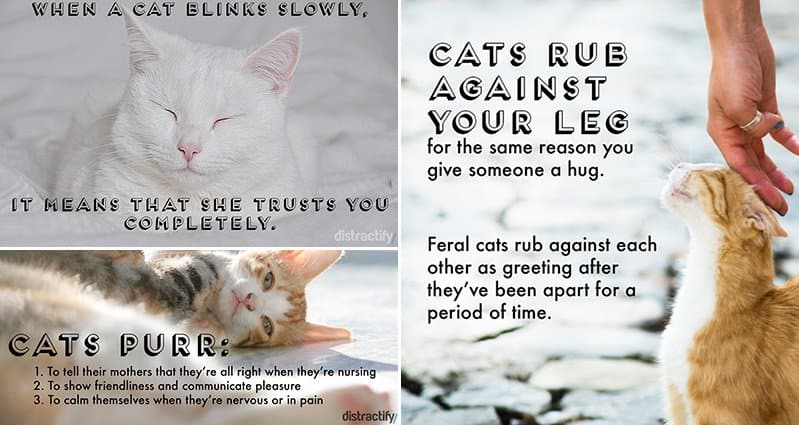
Ingredients
Chicken, Chicken Meal, Turkey Meal, Peas, Turkey, Pea Protein, Chicken Fat (Preserved With Mixed Tocopherols), Flaxseed, Natural Flavor, Dried Tomato Pomace, Salt, Potassium Chloride, Choline Chloride, Salmon Oil, Glycerine, Vitamins (Vitamin E Supplement, Niacin Supplement, Thiamine Mononitrate, D-calcium Pantothenate, Vitamin A Supplement, Pyridoxine Hydrochloride, Riboflavin Supplement, Vitamin D3 Supplement, Vitamin B12 Supplement, Folic Acid, Biotin), Taurine, Cane Molasses, Lactic Acid, Minerals (Zinc Sulfate, Ferrous Sulfate, Copper Sulfate, Manganous Oxide, Sodium Selenite, Calcium Iodate), Citric Acid (Used As A Preservative), Rosemary Extract.
Guaranteed Analysis
Crude Protein: 40%
Crude Fat: 20%
Crude Fiber: 4%
Moisture: 10%
Dry Matter Basis
Protein: 44.44%
Fat: 22.22%
Fiber: 4. 44%
44%
Carbs: 28.89%
Caloric Weight Basis
Protein: 34.91%
Fat: 42.39%
Carbs: 22.69%
What We Liked:
- Primarily made with animal-derived protein
- Free of vaguely-named ingredients
- Features animal-derived fat instead of plant oils
- Doesn’t contain any of the most common irritating additives
- Cats seem to like the way this food tastes
What We Didn’t Like:
- Contains pea protein, a concentrated source of plant protein
- A high-carbohydrate food
- Doesn’t have the moisture your cat needs
#10 Premium Pick: Raised Right Cat Food
Overview:
- Brand Name: Raised Right
- Made In: United States
- Guaranteed Protein: 21% Min
- Age Range: All Life Stages
- Typical Cost Per Day: $2-$5/day
CLICK HERE TO GET 20% OFF YOUR FIRST ORDER
Read Our Full Brand Review
Raised Right is a cat food meal delivery service that makes and sells human-grade food. The meals are formulated by a team of pet nutrition experts, Raised Right’s recipes are lightly-cooked, human-grade foods primarily made from nourishing animal-derived ingredients.
The meals are formulated by a team of pet nutrition experts, Raised Right’s recipes are lightly-cooked, human-grade foods primarily made from nourishing animal-derived ingredients.
If you like the idea of making homemade cat food but don’t feel ready for the time and effort involved, Raised Right is a convenient alternative.
Traceability and transparency are also part of the Raised Right brand. The Raised Right website allows you to learn more about the origins of every ingredient and releases lab reports for each batch.
Raised Right’s turkey & pumpkin recipe is made primarily from turkey thighs, breast, and liver, which are species-appropriate sources of protein and other nutrients. In addition to meat, the recipe contains small amounts of fruit and vegetables. On a dry matter basis, this food is about 10% calories from carbohydrates.
Ingredients:
Turkey Thigh, Turkey Heart, Turkey Liver, Pumpkin, Organic Spearmint, Cod Liver Oil, Egg Shell Powder, Flaxseed Oil, Organic Dried Kelp,Taurine, Thiamine Mononitrate
Guaranteed Analysis
Crude Protein: 21%
Crude Fat: 8%
Crude Fiber: 2%
Moisture: 67%
Dry Matter Basis
Protein: 63. 64%
64%
Fat: 24.24%
Fiber: 6.06%
Carbs: 6.06%
Caloric Weight Basis
Protein: 49.49%
Fat: 45.79%
Carbs: 4.71%
What We Liked:
- A protein-rich food primarily made from animal-sourced ingredients
- Extremely palatable—cats love the taste and texture of this fresh food
- The subscription model gives you access to a team of nutrition experts
- Human-grade food promises a higher level of quality control
- Doesn’t contain any common additives that might harm your cat
What We Didn’t Like:
- Contains fruit and veggies
- Price is above the market average.
What Did We Look For In The Best Cat Food?
Choosing great food involves a variety of factors, including company reputation, ingredient quality, and more. There are many things to consider, but it starts with knowing what your cat’s needs are and how a diet can meet them.
Dr. Chris Vanderhoof, DVM, MPH recommends that cat owners ask themselves several questions before they choose food for their cats.
- What life stage is my cat in (i.e. is your cat a kitten, an adult, a senior)?
- If a senior, does my cat have any specific nutritional needs that a diet can address (muscle loss, arthritis, etc)?
- Is this a cat food that is nutritionally balanced (i.e. does it carry an AAFCO statement and is it meeting at least the minimum nutritional requirements for my cat’s life stage)?
- Does my cat have any medical conditions that can be addressed with a particular diet?
- Does a particular cat food have a moderate caloric density, especially for indoor cats?
- Is this a food that my cat loves and will gladly eat?”
In addition to these personal considerations, there are certain qualities that define (almost) all of the best foods you can buy. All of them stem from your cat’s dietary needs as an obligate carnivore.
Dr. Elizabeth Youens explains that “our domestic pet cats have not altered their physiology much from their wildcat ancestor. Cats are carnivores: they are nutritionally dependent on meat. They also have quite unique needs from their diet, gaining most of their energy from protein rather than carbohydrate and using fats to process certain vitamins and essential nutrients. An extra point to consider for our feline friends is that they cannot make certain amino acids, such as taurine, and so they must be provided as part of their balanced diet.”
With that in mind, here’s what we looked for when choosing the top 10 best cat foods on the market.
First, We Looked For Foods With Low Carbohydrate Content.
Cats use a process called gluconeogenesis to convert protein into glucose. Unlike in people, it is protein, not carbohydrate matter, which is the main type of fuel used to maintain a cat’s blood glucose concentrations.
Cats can metabolize carbohydrates instead of protein, but it’s not ideal.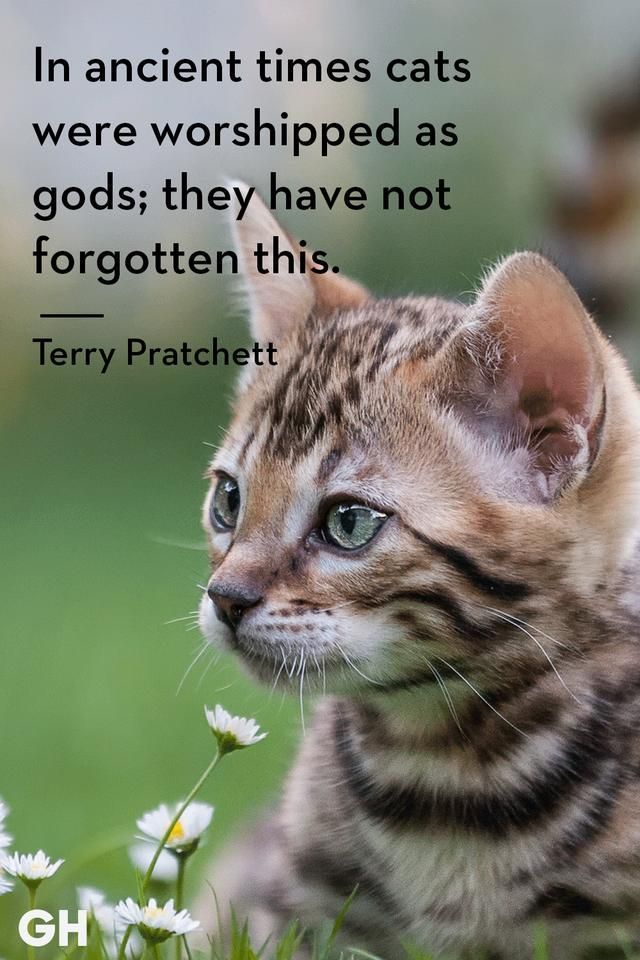 Cats are mildly insulin resistant, similar to a person with diabetes. And sustained carbohydrate intake could make your cat more likely to develop diabetes over time.
Cats are mildly insulin resistant, similar to a person with diabetes. And sustained carbohydrate intake could make your cat more likely to develop diabetes over time.
So How Much Carbohydrate Matter Does A Cat Need?
None. Carbohydrate concentrations between 1 and 10% won’t harm your cat, but anything more is a threat to your cat’s health. Excess carbohydrates can lead to problems like obesity and digestive issues.
Now, finding foods with low carbohydrate content is trickier than it sounds. Unlike a jar of peanut butter or a loaf of bread, cat food labels don’t tell you how many grams of carbohydrates are in each serving. They don’t tell you anything about the carbohydrate content.
The best way to avoid high-carbohydrate foods is by looking for products that don’t contain anything starchy. Read the ingredient list and rule out anything that contains potatoes, wheat, soy, peas, or other high-carbohydrate products.
If you want more details, you can contact the company and ask about carbohydrate content. Alternatively, use a carbohydrate calculator like this one to get a rough estimate.
Alternatively, use a carbohydrate calculator like this one to get a rough estimate.
We Chose Foods That Were Rich In High-Quality Protein.
Cats need a lot of protein. But it’s more complicated than just looking for high-protein food. Instead, we also have to think about the quality of that protein. When choosing the best cat food, we paid attention to the difference between crude protein and digestible protein.
Protein exists on a digestibility spectrum rated by biological value.
For example, 36g of crude protein from feathers is not equivalent to 36g of crude protein from an egg – they have vastly different biological values. An egg has a biological value of 100 (making it highly digestible), while the feather is virtually indigestible.
Yet both the feather protein and the egg protein look lovely on the guaranteed analysis and lend the impression of a high-quality food capable of nourishing your cat.
Digestibility values, not percentages in the guaranteed analysis, are key to measuring nutritional value.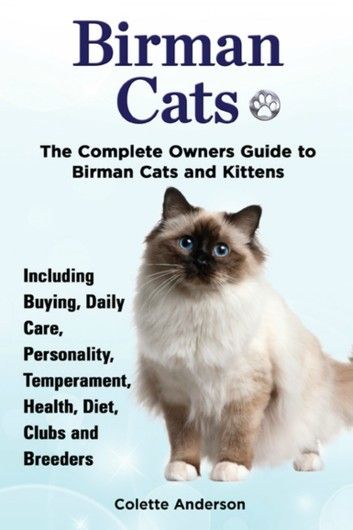
To make things a little more interesting, we don’t know everything about protein digestibility in cats. No one has figured out exactly which protein sources are the most bioavailable or the least. Instead, we’re left to put together a picture based on what scarce information is available.
We Avoided Foods That Contained Animal By-Products.
Animal by-products are one of the most misunderstood ingredients in cat food.
Most people have responded to the AAFCO definition of byproducts with the same sort of nausea that you might feel if served a platter of these ingredients at a restaurant. And yet much of the products that fall into the definition of by-products are highly-nourishing parts of an animal carcass that your cat would love to eat. And there’s nothing disgusting about that.
Digestibility and quality control are the real problems with animal by-products. These vaguely-specified ingredients may be produced from any number of animal parts from any number of different animals.
A former AAFCO president once emphasized how loosely regulated these ingredients are by stating that “You don’t know if it’s cattle or sheep or horse – or Fluffy.”
Besides not knowing what type of animals contributed to the by-product stew, you don’t know if it contains more wholesome liver or nutritionally void chicken feet. If you want to ensure maximum protein digestibility, avoid meat by-products and other vaguely-named ingredients like “meat”, “poultry”, and “meat and bone meal”.
We Looked For Foods That Kept Plant Protein To A Minimum.
While it’s unclear exactly where each source of plant protein lies on the digestibility spectrum, we do know that protein from peas, potatoes, and other plants is less efficient than that from animal ingredients. While a single prey animal offers all the amino acids a cat needs, plant ingredients need to be combined with animal protein and synthetic additives to recreate that mix of amino acids.
Furthermore, many cat guardians report that their cats have less waste when they’re eating a diet composed primarily of animal-sourced protein.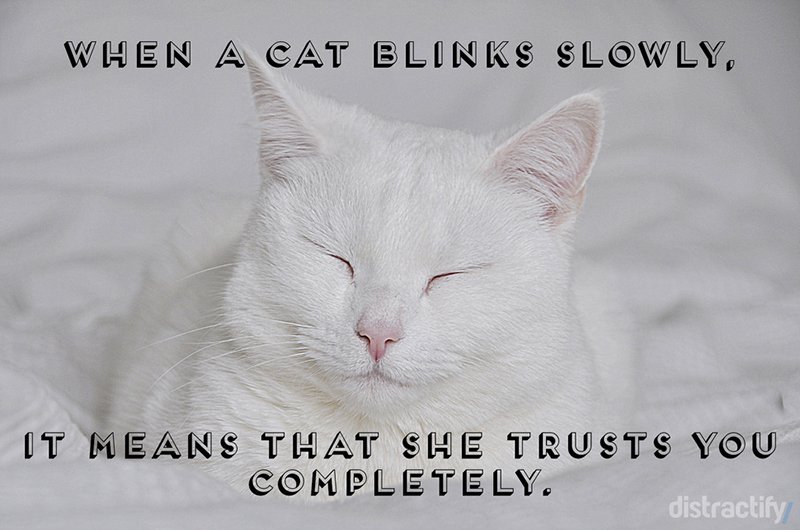
What About Vegan And Vegetarian Cat Food?
It’s understandable to have misgivings about the impact of the livestock industry and the amount of meat used to produce pet food. While we don’t recommend any vegan foods, you can learn more about them in this article.
Many cats seem to do well on vegan food. A combination of plant ingredients and synthetic additives are capable of, at least according to our current understanding, recreating the mix of nutrients your carnivore requires. But it may be foolish to believe that we can recreate a perfect facsimile of the nutritional profile found in cats’ prey. Doing so may lead to unexpected nutritional deficiencies or overloads.
We Gave Preference To Moisture-rich Foods That Keep Your Cat Hydrated.
Our cats’ ancestors were desert dwellers. They lived in arid environments where fresh prey was often the best source of moisture. A mouse is about 70% water and a fine source of hydration for a desert cat hours away from the nearest watering hole.
Because fresh water was scarce, early wild cats evolved to have low thirst drives and a natural inclination to get their water from the moisture-rich bodies of their prey. This means that they typically don’t drink enough water to compensate for moisture-depleted dry food.
We Looked For Foods That Were Free Of Potentially Harmful Ingredients And Additives.
The Best Cat Food Is Free Of Carrageenan.
This natural seaweed extract is a great binder and thickener for canned cat food, but it has a bad reputation. Studies have shown that carrageenan creates inflammation in the body and may exacerbate cancer.
The Best Cat Food Doesn’t Contain Artificial Ingredients.
Artificial flavors are unnecessary if the food is made with nourishing meat ingredients. No cat needs artificial colors. In addition to being unnecessary, food dyes are tied to behavioral issues and cancer development in both humans and animals.
BHA, BHT, and ethoxyquin are popular preservatives that are associated with serious problems. Most pet foods have replaced them with natural alternatives including Vitamin E (mixed tocopherols), rosemary extract, and other antioxidants. Although ethoxyquin rarely appears on the ingredient list, it may enter your cat food as a fish preservative.
Most pet foods have replaced them with natural alternatives including Vitamin E (mixed tocopherols), rosemary extract, and other antioxidants. Although ethoxyquin rarely appears on the ingredient list, it may enter your cat food as a fish preservative.
We Looked For Brands With Excellent Reputations.
Remember that you’re relying on the cat food company to provide your cat the nutrition they need to stay healthy and vibrant – potentially for the rest of their life.
You need a company and a brand that you can trust. While it doesn’t tell us everything about the brand, a company’s recall history provides key insights into its ethics, safety standards, and the quality of its products.
If a company faces voluntary, or worse—mandatory—recalls every five years, purchasing from that company could subject your cat to three or more potentially harmful slip-ups during their lifetime.
A communicative, transparent company isn’t afraid to share information with their customers. We gauged the quality of cat food companies by contacting their customer support lines and evaluating their customer service. We gave preference to companies that responded promptly and were willing to provide key information.
We gauged the quality of cat food companies by contacting their customer support lines and evaluating their customer service. We gave preference to companies that responded promptly and were willing to provide key information.
Additionally, we paid attention to what other customers were saying about the brand. Through social media, blogging, reviews on retail platforms, and sites like Consumer Reports, consumers can easily share their complaints or praises with the world.
We read these reviews and used them to assess the customer experience.
Understanding Cat Food Labels And Marketing
Natural, Organic, And Human Grade: Are They Meaningless Buzzwords?
Until recently, the description “scientifically formulated” was a popular pet food marketing catchphrase. People wanted to imagine their cat’s food as being formulated by scientists in a sterile laboratory.
Today’s cat food consumer has a different ideal. They’re looking for food that’s gently crafted, fresh from the farm, non-GMO, natural, and based on real meat.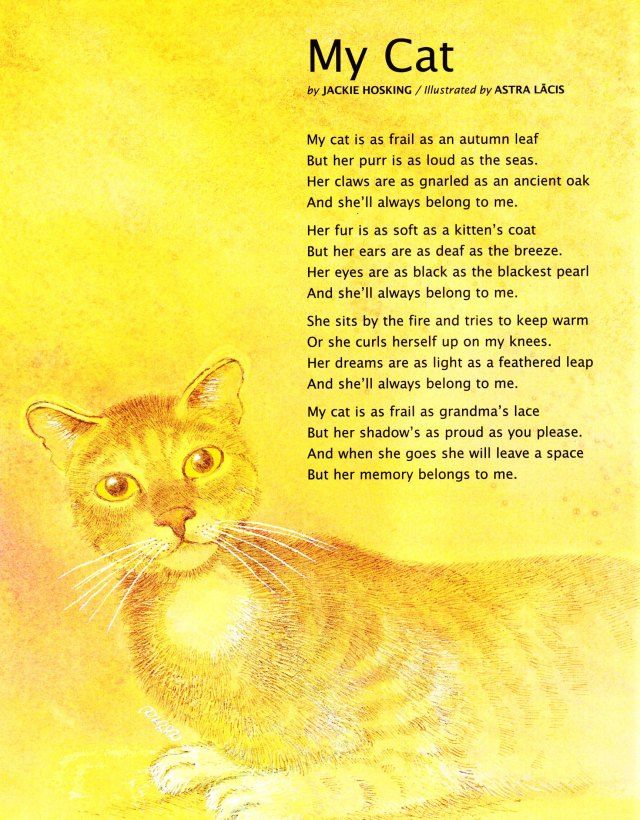 Thanks to the ‘back to nature’ trend, the number of natural or organic cat food labels has skyrocketed. Numerous brands capitalize on the “premium natural food” concept.
Thanks to the ‘back to nature’ trend, the number of natural or organic cat food labels has skyrocketed. Numerous brands capitalize on the “premium natural food” concept.
But are they healthy for your cat?
Natural
The “natural” label is loosely defined and lightly regulated. FDA guidelines dictate that any food bearing the “natural” label must be manufactured without undergoing any chemical alterations.
Also Read: Best Holistic Cat Food: Our Top 5 Picks
Organic
The organic label, however, has some legitimacy.
The National Organic Program defines organic products as those “produced through approved methods that integrate cultural, biological and mechanical practices that foster cycling of resources, promote ecological balance and conserve biodiversity. Synthetic fertilizers, sewage sludge, irradiation and genetic engineering may not be used.”
But while the term “organic” does mean something in terms of the ingredients your cat’s food contains, it doesn’t tell you a lot about how nutritious that food is. Organic foods can be just as species-inappropriate and unwholesome as anything else on the cat food shelf. You’ll just pay a little more for them.
Organic foods can be just as species-inappropriate and unwholesome as anything else on the cat food shelf. You’ll just pay a little more for them.
Also Read: Best Organic Cat Food
Human Grade
To earn “human grade” status, pet food must start with human-quality ingredients. But ingredient quality isn’t the end of the story. To keep its human-grade status, a food must be manufactured in a USDA-inspected human food processing facility.
The manufacturing facility is a vital part of this story. Any ingredient, once processed in a pet food manufacturing plant, is legally considered “feed grade”.
So human-grade food isn’t necessarily made from better ingredients. In fact, veterinarian Dr. Sarah Reidenbach says that “this term likely makes no difference in the safety or nutritional value of the pet food.”
Do Life Stages Matter When You’re Choosing Cat Food?
Yes and no. Choose foods that meet AAFCO nutritional guidelines for either growth, all life stages, or adult maintenance.
Kittens and pregnant or lactating cats should eat food formulated for growth or all life stages. Adults—cats over the age of one—should eat meals formulated for all life stages or adult maintenance.
Other than these three categories, you don’t need to choose your cat’s food based on life stages. Seniors, for example, don’t usually need senior-specific food. Most of these labeling ploys are in the same league as indoor cat food, hairball food, and breed-specific formulations.
They’re easy to buy and feel like a little bit of personalization, but they jump straight to the personal details without nailing nutrition basics. How can you address the unique needs of a 7-year-old indoor-outdoor Persian without first acknowledging the fact that she’s a carnivore?
Is Grain-Free Cat Food Better Or Worse?
When we originally published this article in 2018, the grain-free trend was reaching its peak. Right around the same time, the FDA quietly began an investigation that would turn the trend on its head.
While we don’t have the answers about the potential connection between grain-free foods and dilated cardiomyopathy, we do know that grain was never the problem. Cats don’t need to avoid grain or gluten. They need to avoid excessive carbohydrates.
Grain-free foods often replace grain with an unhealthy dose of biologically inappropriate ingredients like potatoes and peas. Now that those ingredients are losing their appeal, the solution isn’t to go back to grains. The solution is avoiding plant ingredients.
Also Read: 10 Best Grain Free Cat Foods
Are Prescription Diets Good For Cats?
There is no law saying that prescription foods can be sold only with a veterinarian’s prescription. They are not drugs or medication. They’re food.
Quoting the FDA/CVM Communications Staff Deputy Director: “‘Prescription diet’ is an industry-coined term and holds no legal meaning.”
In many cases, prescription foods are perfect for the condition for which they’re marketed. Some prescription cat foods, however, are no better than the average food sold on a grocery store shelf.
Some prescription cat foods, however, are no better than the average food sold on a grocery store shelf.
A particularly ironic example is prescription dry food for urinary tract health. Because dry food can promote urinary tract disease, this marketing slant adds insult to injury. The final word on prescription cat food is that it can be both good or bad. Stay skeptical and evaluate each product on an individual basis. If you’re unsure about evaluating prescription food options on your own, your veterinarian can help you.
Whether You Choose One Of Our Top Picks Or Another Product, Look For Foods That Honor Your Cat’s Carnivorous Needs.
Choosing the right cat food is simple when you understand the fundamentals of species-appropriate nutrition. Cats are obligate carnivores who could thrive on a diet of raw prey alone. Regardless of brand, price, or format, the best foods resemble that prey-centric diet.
Want More? Browse Our Dozens Of Unbiased Reviews And Detailed Guides
Additional Resources:
- Cats are Obligate Carnivores
- Making Cat Food: Homemade and Raw Cat Food Diets
- The Complete Guide To Feline Nutrition
Frequently Asked Questions
What is the best dry cat food?
The best dry cat food is rich in animal-derived protein, low in carbohydrate content, and made from high-quality ingredients.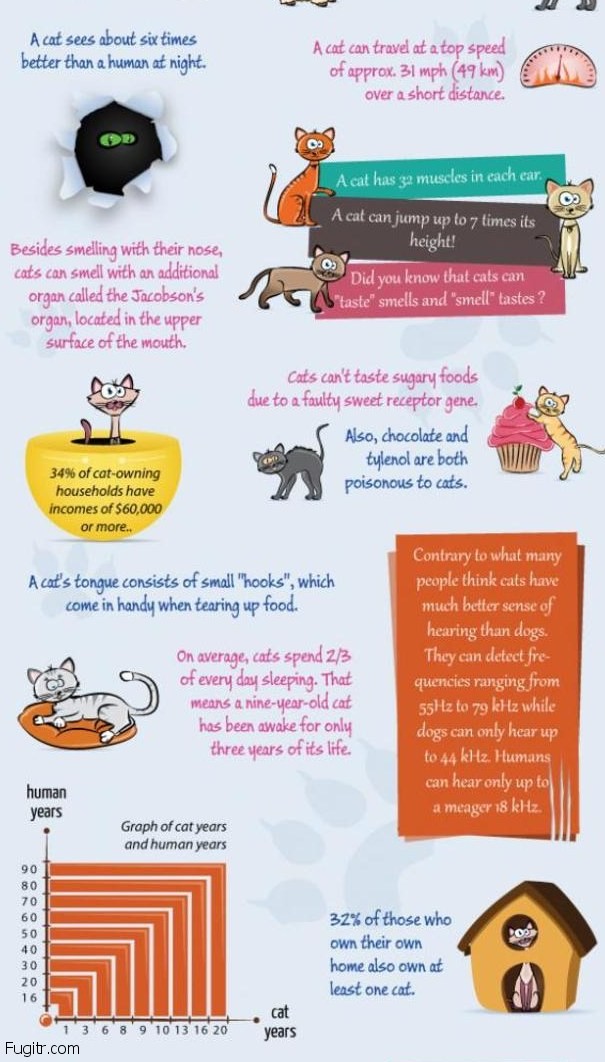 Some of the best dry cat food brands include Ziwi Peak, Dr. Elsey’s cleanprotein, and Tiki Cat Born Carnivore.
Some of the best dry cat food brands include Ziwi Peak, Dr. Elsey’s cleanprotein, and Tiki Cat Born Carnivore.
What is the best wet cat food?
The best wet cat food honors your cat’s needs as a carnivore. It’s a meat-rich product that delivers all the protein, fat, and micronutrients your cat needs without a lot of plants and starch. A few of our favorite brands include Feline Natural, Hound & Gatos, and Nom Nom.
What is the best healthiest cat food?
The healthiest cat food is nutritionally complete and balanced, emphasizing meat over plants and protein over starch. Look for expert-formulated recipes that were made with carnivores in mind.
Is dry or wet food best for cats?
Because it’s more hydrating and typically lower in carbohydrates, wet food is best for cats. A dry diet is convenient, but it could increase your cat’s chances of developing urinary tract disease or diabetes over time.
This is interesting: Little-known details about domestic cats
Today - about these amazing creatures.
26 facts about cats
1. When chasing prey, the cat keeps its head horizontally at the same level, while dogs and people shake their heads up and down.
2. Cats are mostly right-handed, and cats are mostly left-handed. An interesting fact is that 90% of people are right-handed, and the remaining 10% are left-handed, and they are mostly men.
3. A cat cannot climb down a tree upside down because all the claws on its paws point in the same direction. So the cats have to climb down the tree backwards.
4. Scientists believe that a cat can pronounce consonant sounds: m, n, r, x, f, v.
5. Cats can reproduce up to 100 different sounds, and dogs only 10.
6. The brain of a cat, unlike a dog, is more like a human brain. Cats and humans have identical areas of the brain that are responsible for emotions.
7. During the Spanish Inquisition, Pope Innocent VIII recognized cats as the incarnation of the devil and thousands of cats were burned. This led to an increase in the population of rats, which exacerbated the effects of the plague, nicknamed the "black death". Did the cat god take revenge?
This led to an increase in the population of rats, which exacerbated the effects of the plague, nicknamed the "black death". Did the cat god take revenge?
8. According to legend, Noah prayed to God to help protect all the food in the ark from rats. In response, God caused the cat to appear when the lion sneezed.
9. In Siam, when a new king was crowned, the cats rode in a carriage at the head of the procession.
10. For short distances, a cat can reach a speed of about 49 km/h.
11. A cat can jump up to five times its height.
12. Cats almost always land on their feet: the organs of balance are located in the cat's inner ear, and the tail also helps to align the trajectory.
13. Cats rub against people not only because they are affectionate, but also to mark their territory with scent glands located around their muzzle.
See also: 10 most dangerous dog breeds
14. Scientists are still debating exactly how a cat purrs. Most believe that the vibration of the vocal cords, located deep in the throat. To do this, the muscles of the larynx open and close the air passage about 25 times per second.
To do this, the muscles of the larynx open and close the air passage about 25 times per second.
15. When a cat died in a family in ancient Egypt, family members shaved their eyebrows as a sign of grief. The cat was embalmed, the mummy was placed in the family crypt or in the animal cemetery along with the mouse mummies. In 1888, over 300,000 mummified cats were found in Egyptian cemeteries.
16. The earliest ancestor of the modern cat lived about 30 million years ago.
17. A cat usually has 12 whiskers on each side.
18. The ability of cats to find their way home is explained by the fact that cats either use the angle of sunlight, or they have magnetized cells in the brain that act as a compass.
19. A cat's jaw cannot move sideways, so they cannot chew large pieces of food.
20. The back of a cat consists of 53 vertebrae. Humans only have 34.
21. One third of cat owners think their pets can read their minds.
22. The most famous long-lived cat was Puff from Texas, who died in 2005 at the age of 38.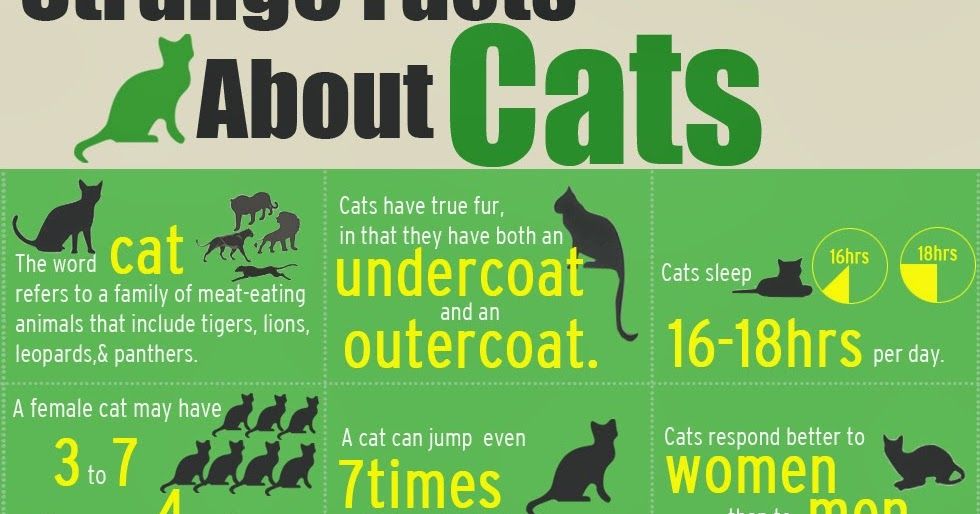 Ordinary cats can live up to 20 years (approximately 96 human years).
Ordinary cats can live up to 20 years (approximately 96 human years).
23. A cat's nose has a unique print, just like human fingerprints.
24. Cats can detect an earthquake 10-15 minutes before a person feels it.
25. They talk to their cats 95 percent of their owners.
26. Cats are aliens. Even some scientists believe this. In their opinion, the main task of cats is to observe creatures on Earth, and the proof of their alien origin is amazing abilities that other animals do not have.
Mustachioed records
"Boeing" is resting!
The loudest cat in the world was found - Briton Smokey: his purring can drown out even the sound of the Boeing 737 engine, because he makes sounds at 92 decibels (an airplane landing has a similar "loudness"). His owners claim that the cat purrs so loudly that they can't hear the TV and can't talk on the phone. Scientists have checked and confirmed: "accusations" are justified.
Didn't expect
One New York cat was forgotten by its owner when moving to another state. Five months later, upon returning home, the owner found the pet curled up in his favorite chair. The cat has covered more than 3.5 thousand km.
Five months later, upon returning home, the owner found the pet curled up in his favorite chair. The cat has covered more than 3.5 thousand km.
Flyer
Beagles the cat from Australia was sent by the owners to Auckland (New Zealand). The Australian airline Quintas experienced real stress: the cat did not arrive at its destination, but a week later it was found ... in the cabin of another plane that flew to Sydney. During this week, the wanderer flew around almost the whole world, having managed to travel from Australia to New Zealand, and then from Melbourne to Sydney and from Fiji to Singapore.
Kulibina
The scientist Bernard Courtois was doing some chemical experiments in 1811, and his beloved cat was sitting on his shoulders. Suddenly there was a knock on the door, a frightened cat jumped off the shoulders of the chemist and broke the flasks with chemicals standing on the table. In one of these flasks there was an alcoholic tincture of seaweed, and in the other ferrous sulphate. The contents were mixed, a violent reaction began with the release of smoke.
The contents were mixed, a violent reaction began with the release of smoke.
When the reaction was over and the smoke settled, the scientist saw brown crystals on the table. These crystals were subsequently named - "iodine". It is a pity that the name of the inventor was not preserved in history.
Next to the greats
The English king Charles I adored cats: he believed that without his beloved cat he would never be happy. He was so worried about the health of his pet that he even assigned guards to her. The cat died, and a few days later the king was executed.
Oligarchs
A wealthy lady opened accounts in Switzerland for her cats. The Swiss Royal Society for the Protection of Birds fined these cats for hunting - they were charged with "systematic killing of birds." The fine was paid from the cat's account. For confirmation, a bank employee issued a form with paw prints of "depositors".
In the service of the Queen
Great Britain's most famous cat is the late Wilberforce.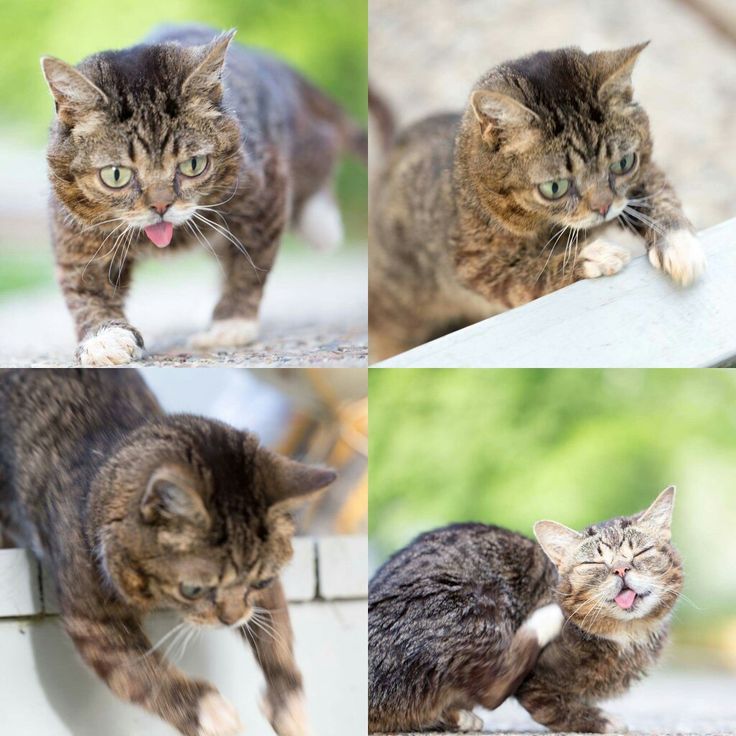 He lived in the prime minister's residence, where he was assigned to catch mice. He has served under four prime ministers. Sometimes the cat was even allowed to attend government meetings! Margaret Thatcher brought him treats from all over the world. When Wilberforce died, Margaret Thatcher announced this right at a cabinet meeting.
He lived in the prime minister's residence, where he was assigned to catch mice. He has served under four prime ministers. Sometimes the cat was even allowed to attend government meetings! Margaret Thatcher brought him treats from all over the world. When Wilberforce died, Margaret Thatcher announced this right at a cabinet meeting.
7 Cat Facts Every Cat Lover Should Know
Like any other animal, cats are a long-term commitment and responsibility, to which pets respond with boundless love. Below are 7 facts about cat care that owners need to know.
1. Your cat is a predator
Although some people follow a vegetarian or vegan diet, these diets are contraindicated for a cat. Humans are omnivores, while cats are natural carnivores. They do not digest plant foods very well and need the protein taurine, which they can only get from animal muscles and tissues.
Domestic cats obtain the nutrients they need by eating dry or wet commercial foods containing animal products.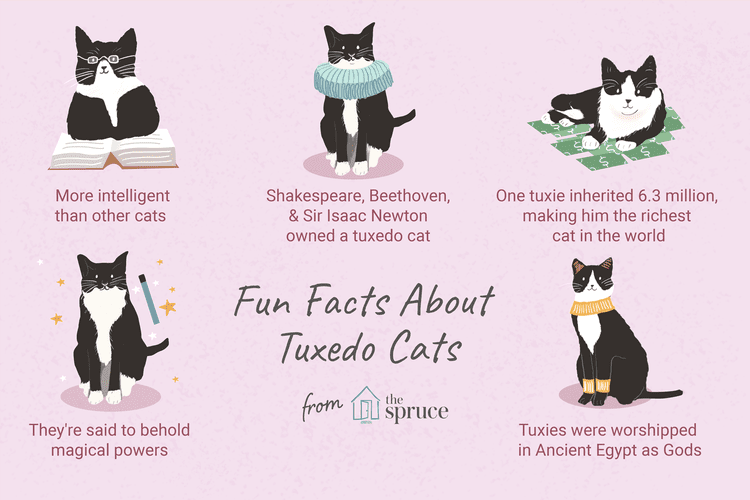
Don't stop thinking not only about what you feed your cat, but also about how much food you give her. Controlling your cat's weight is the very first thing you can do to increase your cat's lifespan.
2. Cats hate dirty litter boxes and don't like to share them.
Your cat is obsessed with cleanliness. This means that you should clean the tray at least once a day! The best option is to remove solid waste every day, every week to completely clean and wash the tray.
Keeping the litter box clean will cause your cat to urinate more frequently, which can help reduce the risk of potentially fatal urinary tract diseases in cats.
Cats don't like to share, so if you have more than one cat, you'll need a separate tray for each cat. These trays should be located in a quiet and secluded place!
3. Some houseplants are dangerous for cats
Not sure which plants are toxic to cats? See the list of plants and symptoms of cat poisoning on this site. If the list includes plants that you have at home, then it is better to get rid of them as soon as possible. If you think your cat has eaten something poisonous, contact your veterinarian for emergency care as soon as possible.
If the list includes plants that you have at home, then it is better to get rid of them as soon as possible. If you think your cat has eaten something poisonous, contact your veterinarian for emergency care as soon as possible.
4. Cat teeth should be cleaned and kept clean
That's right! Cats have almost as many teeth as humans, and these teeth also develop plaque and tartar. Caring for a cat's teeth is similar to how we take care of our teeth. You can brush your cat’s teeth at home (it’s important to use a special toothpaste and brush for cats!), and check their condition at the annual check-up with a veterinarian.
5. Vomiting in cats is an abnormal condition
It is a common misconception that it is normal for cats to vomit. A single bout of vomiting is usually not a cause for concern. But if a cat vomits frequently and / or regularly, the cause may be food allergies, helminth infections, or other more serious diseases. If your cat vomits frequently, it's a good idea to go to the veterinarian for a checkup without delay.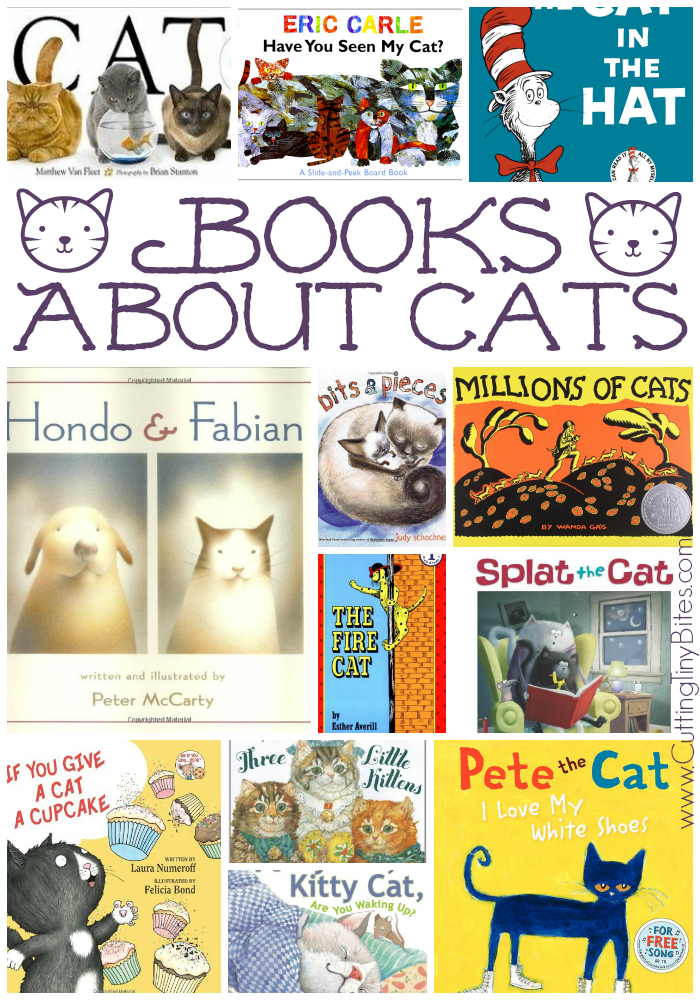
6. Cats are masters at masking pain
You probably won't think that a cat's health has deteriorated, because cats are great at hiding their pain and other signs of illness. Please contact the veterinary clinic at the first sign of a deviation from the normal, usual condition of the cat.
Veterinarians are able to see the disease before it becomes irreversible. That is why it is important to conduct a medical examination of a cat annually.
7. Cats require regular vaccinations and parasite treatments
Even if a cat does not go outside, this is not a guarantee of protection against viruses, fleas and helminths. You can bring viruses and parasites from the street on your clothes and shoes. The risk of infection increases greatly if you have other animals or a cat goes outside (for example, in the summer in the country).
Every year we find infections and parasites in dogs less and less, while in cats the infection rate remains high. Despite the fact that dogs regularly go outside, they are tried to be regularly vaccinated and treated against fleas and ticks.

